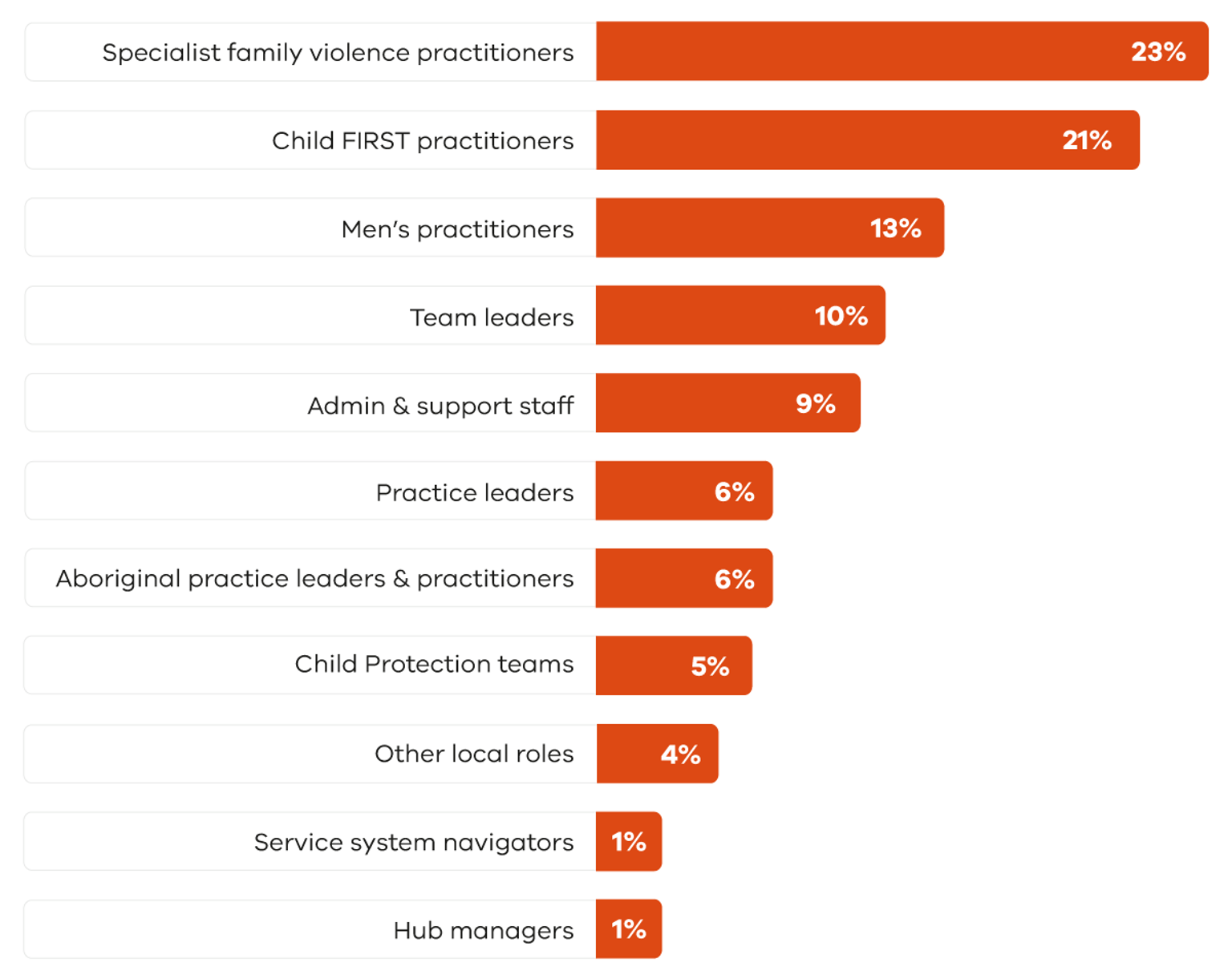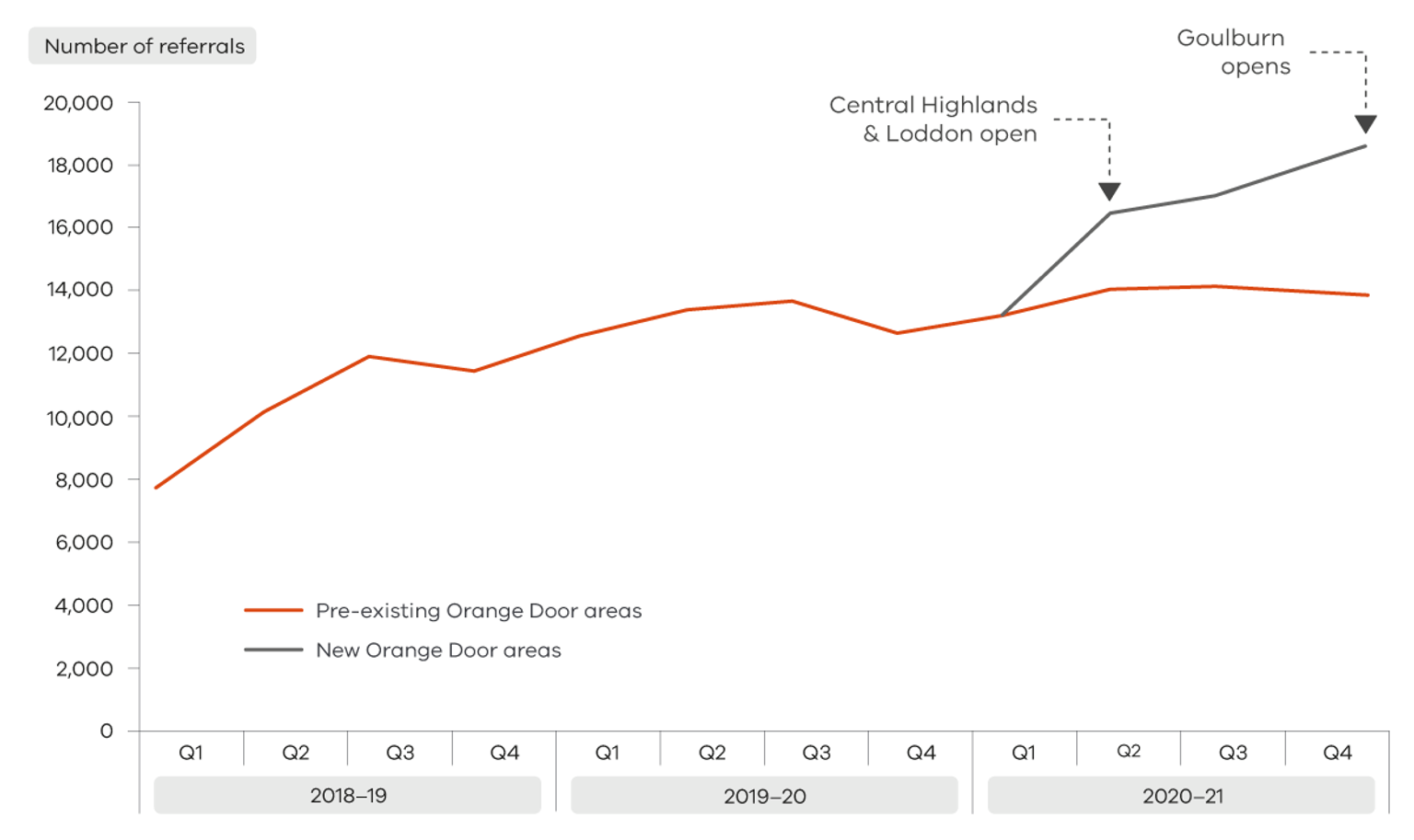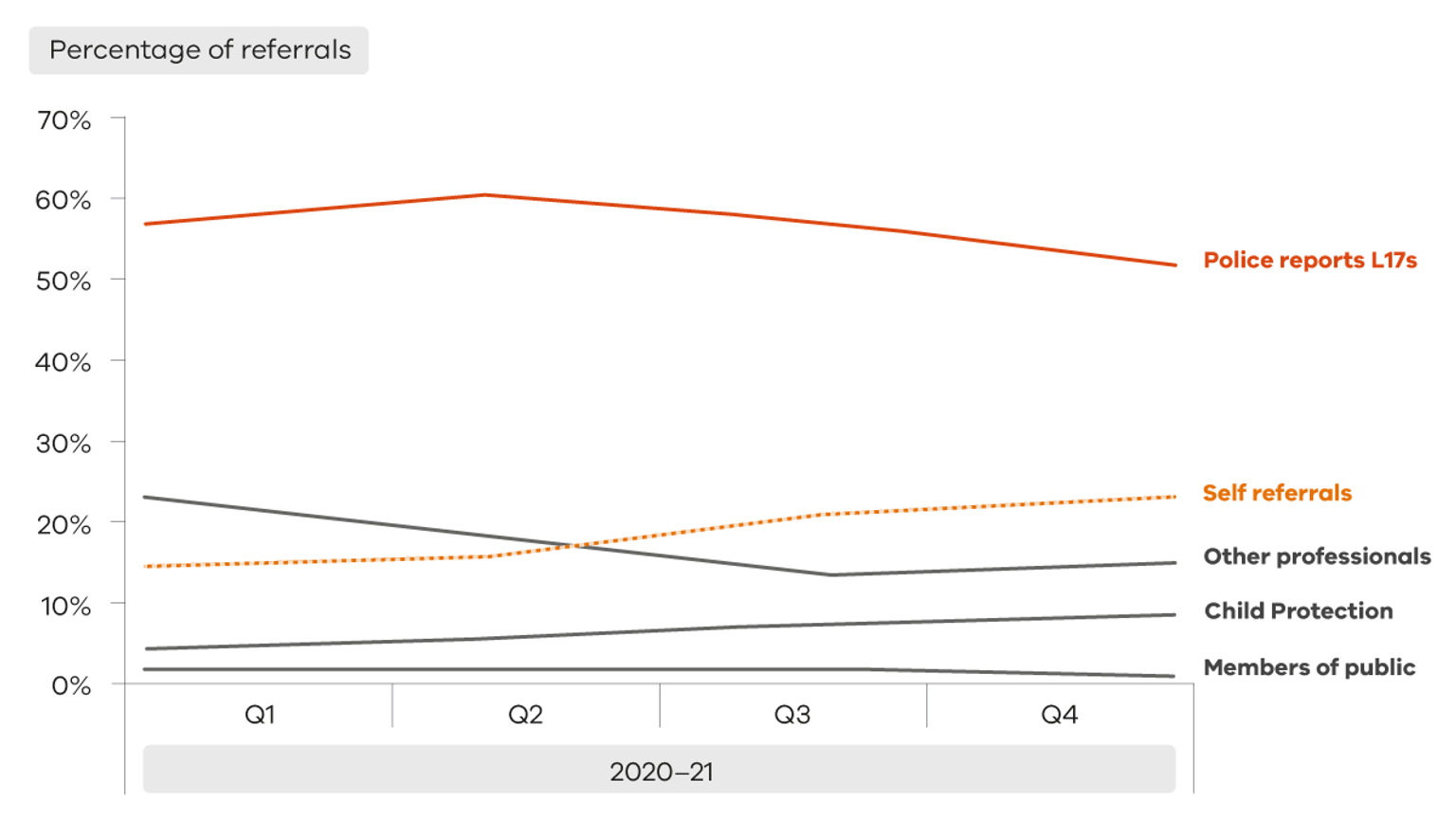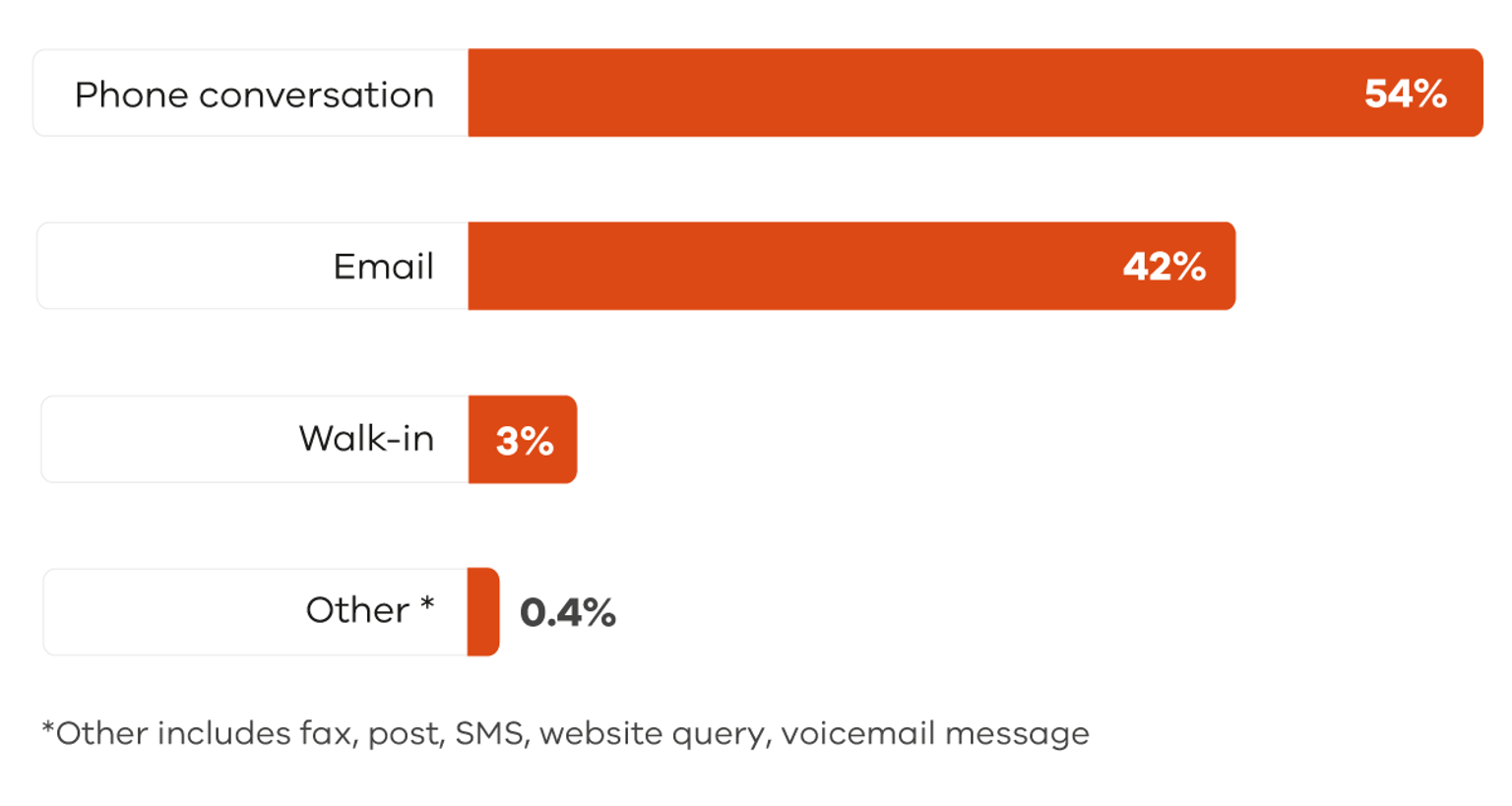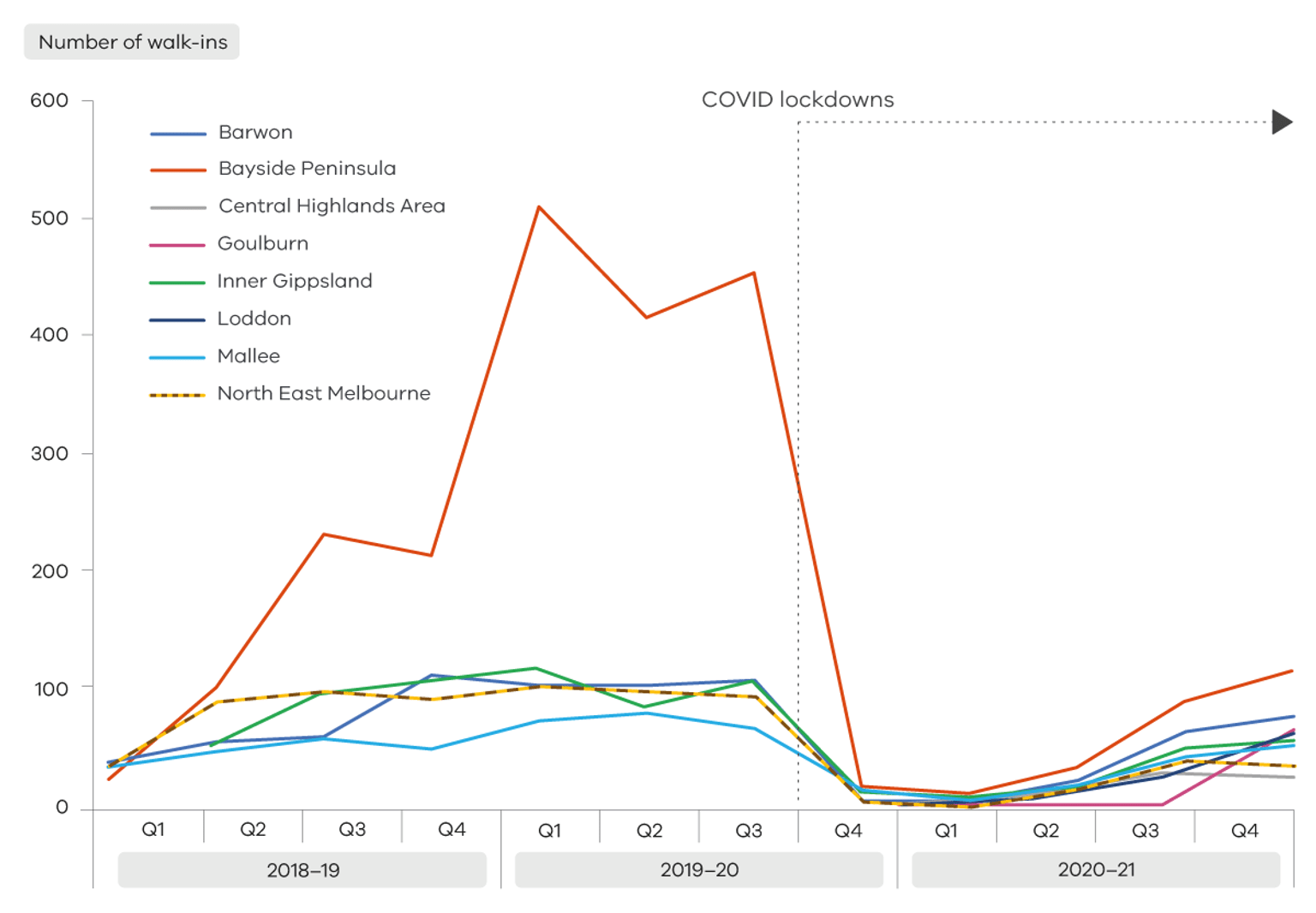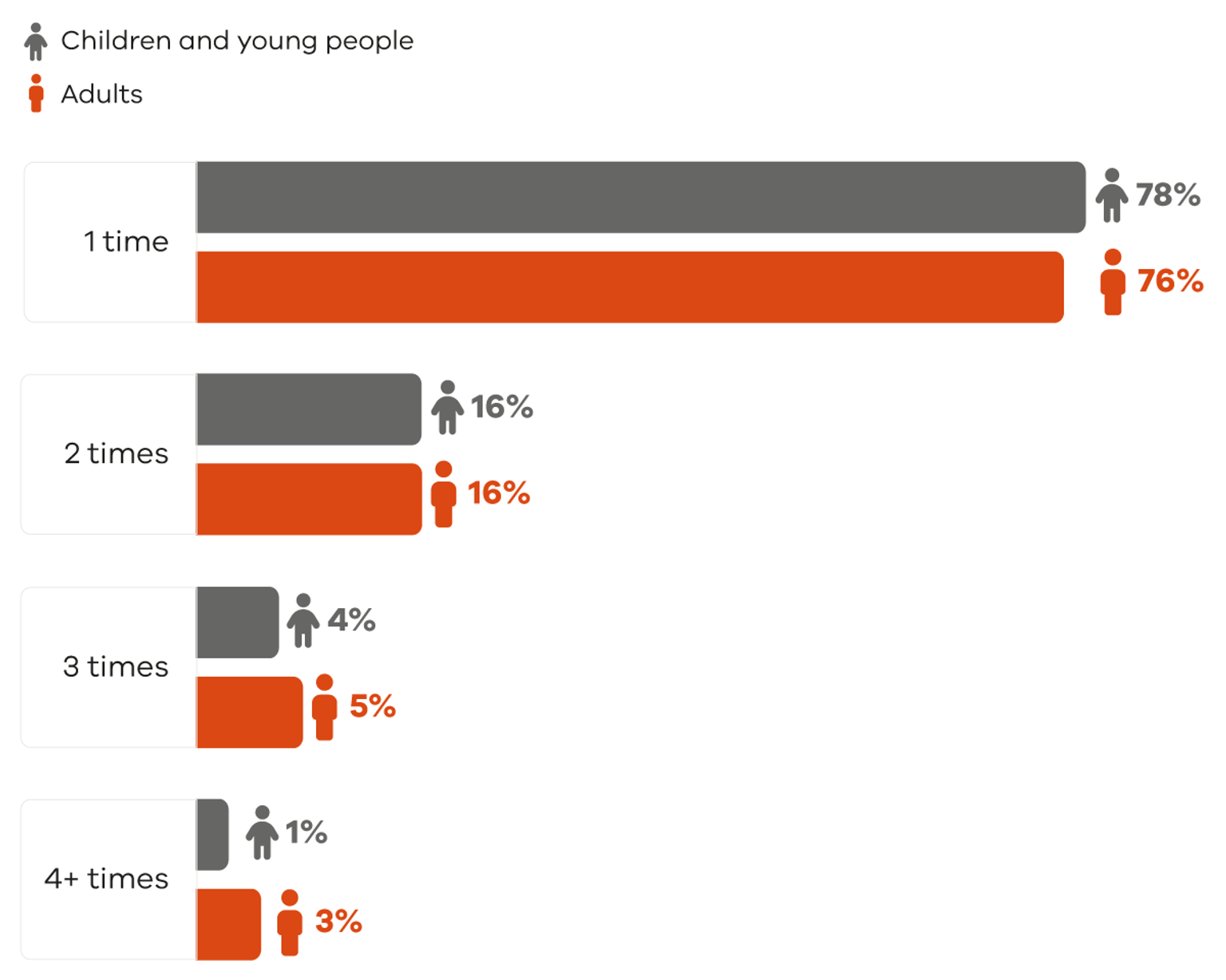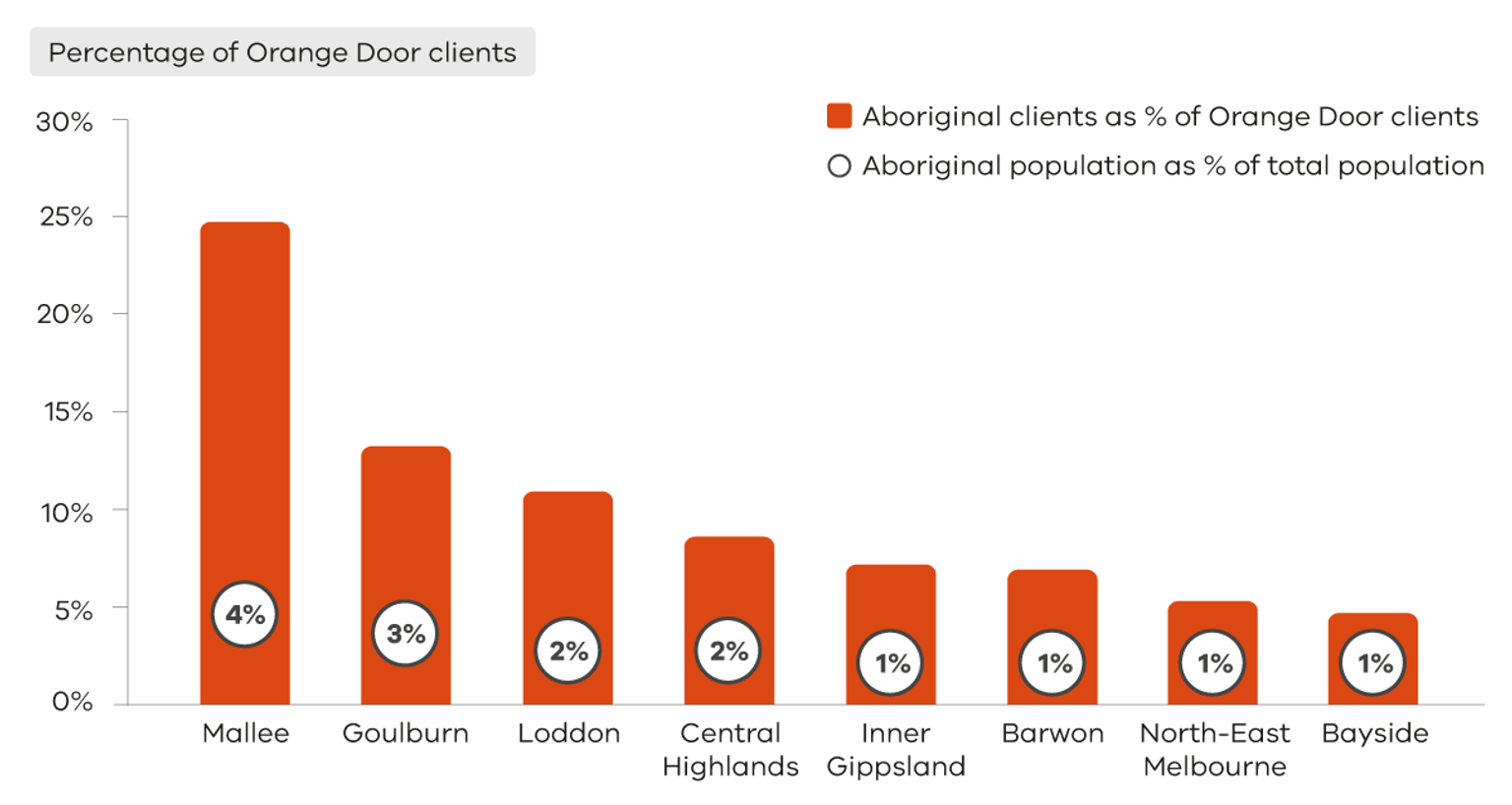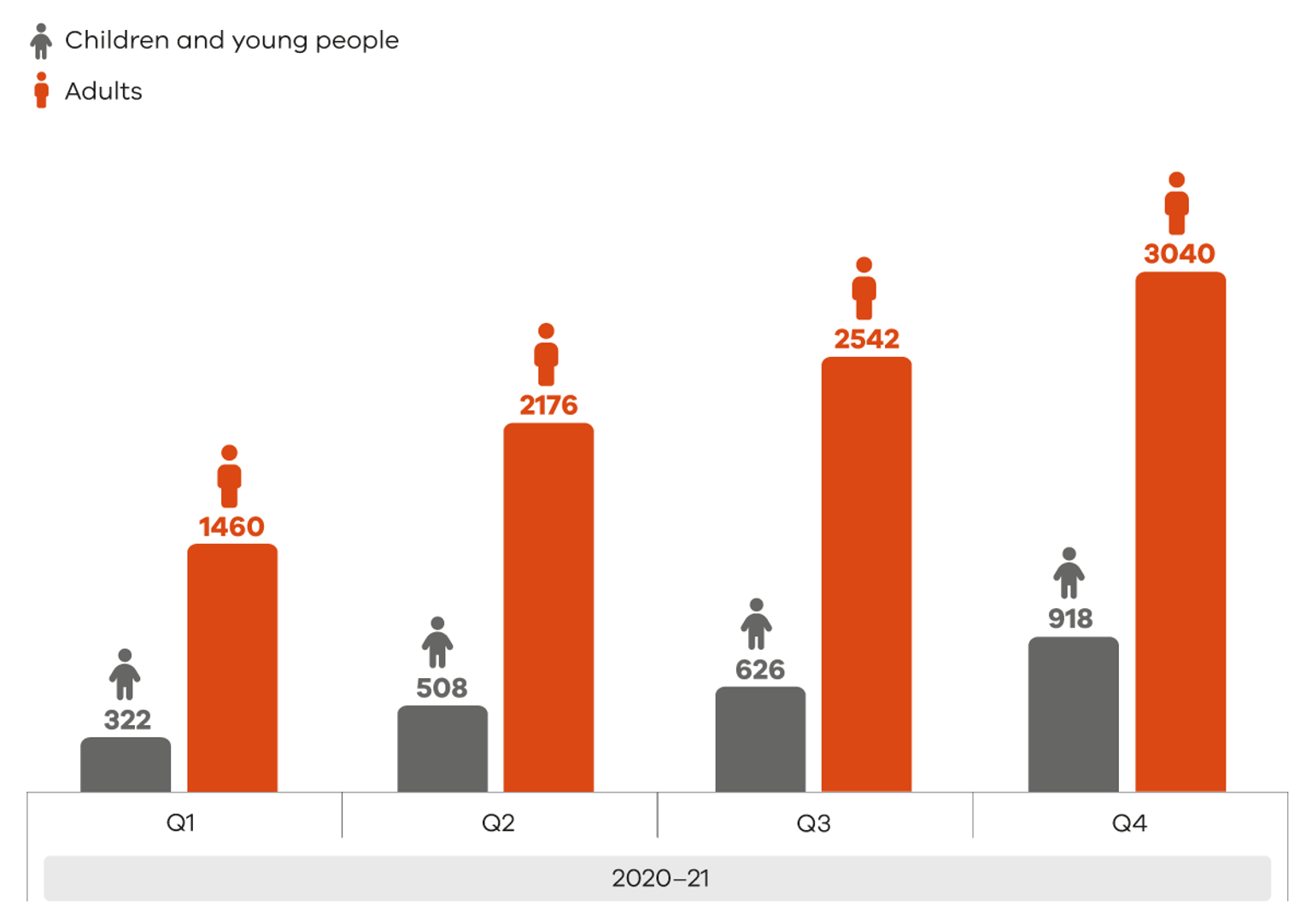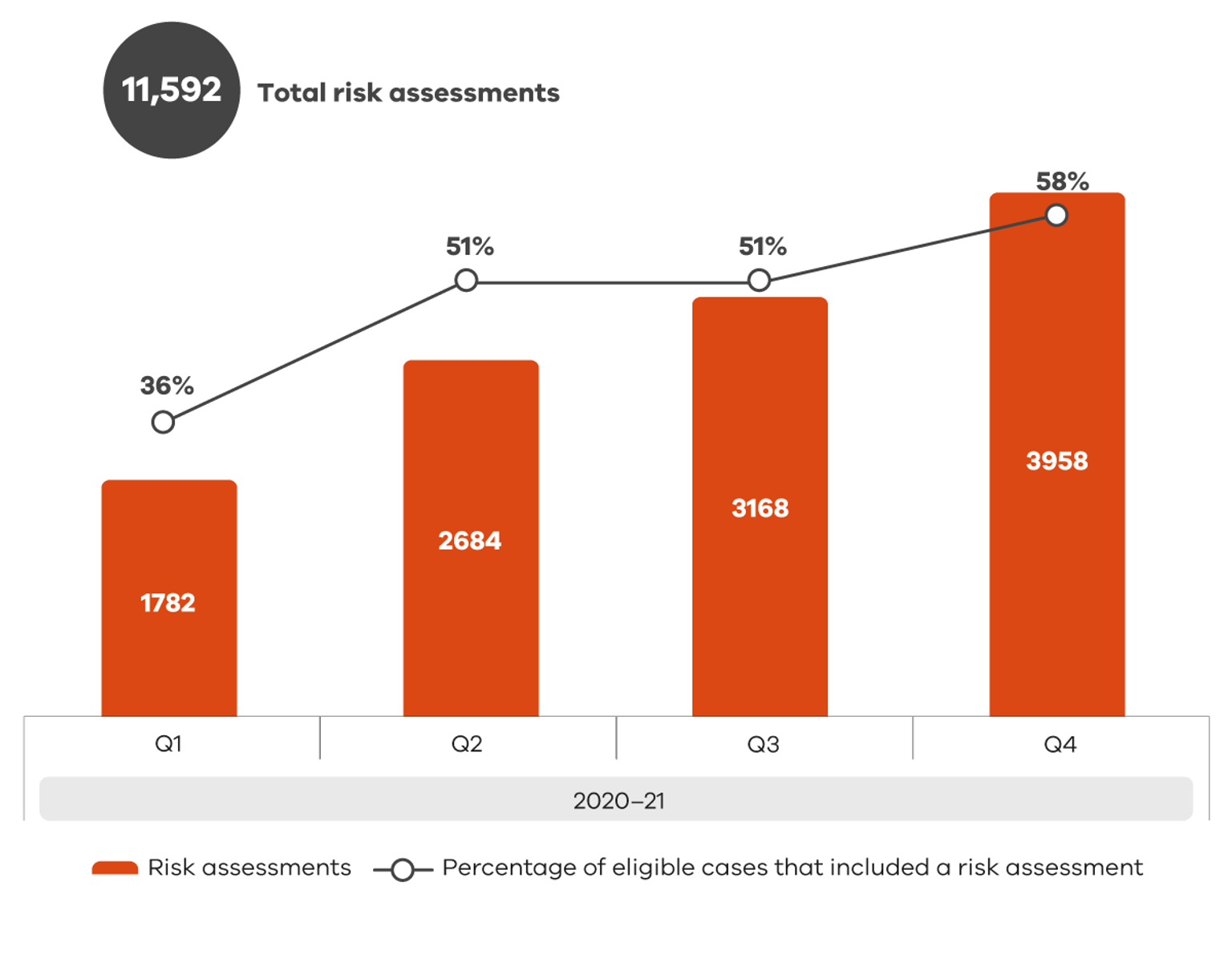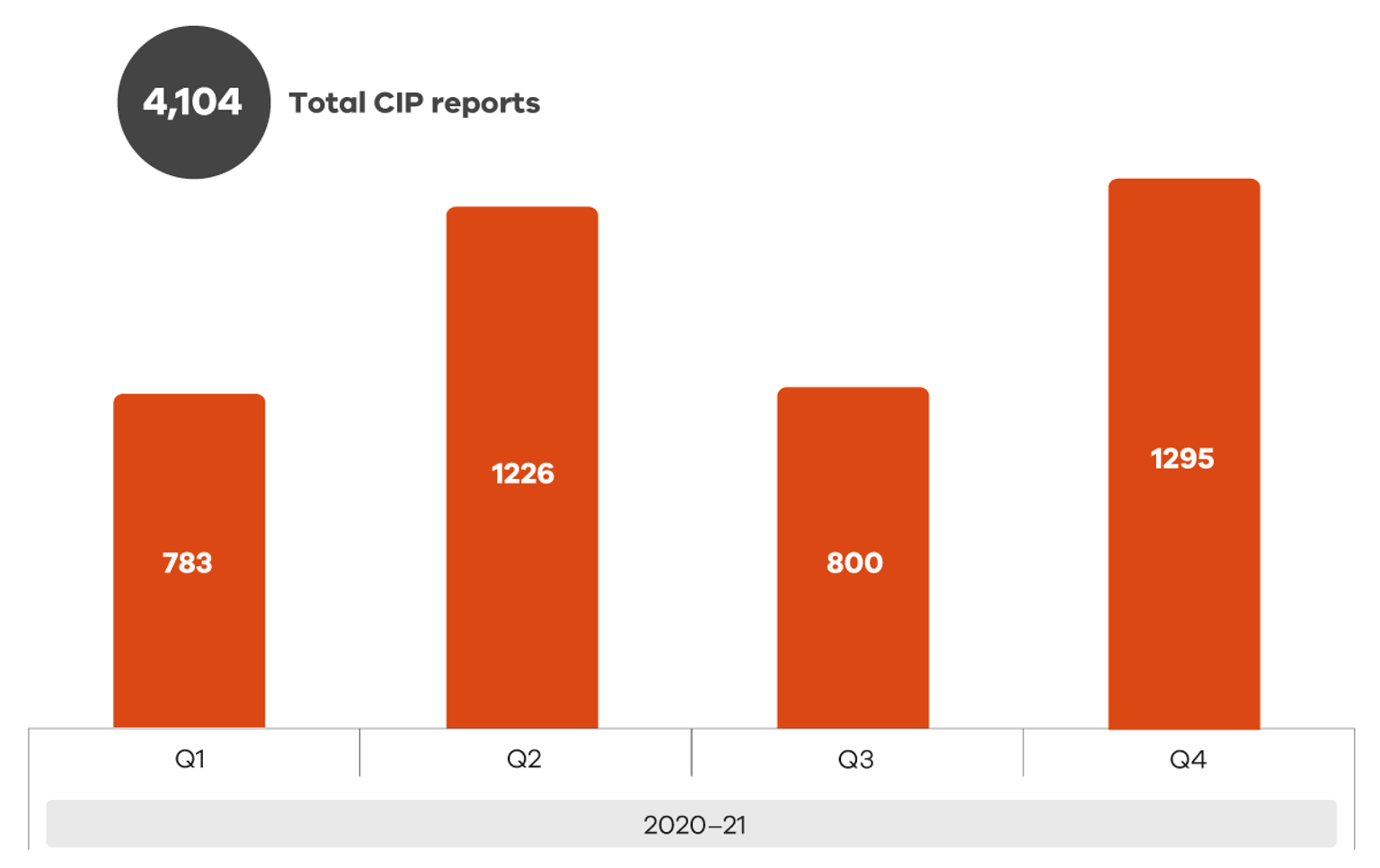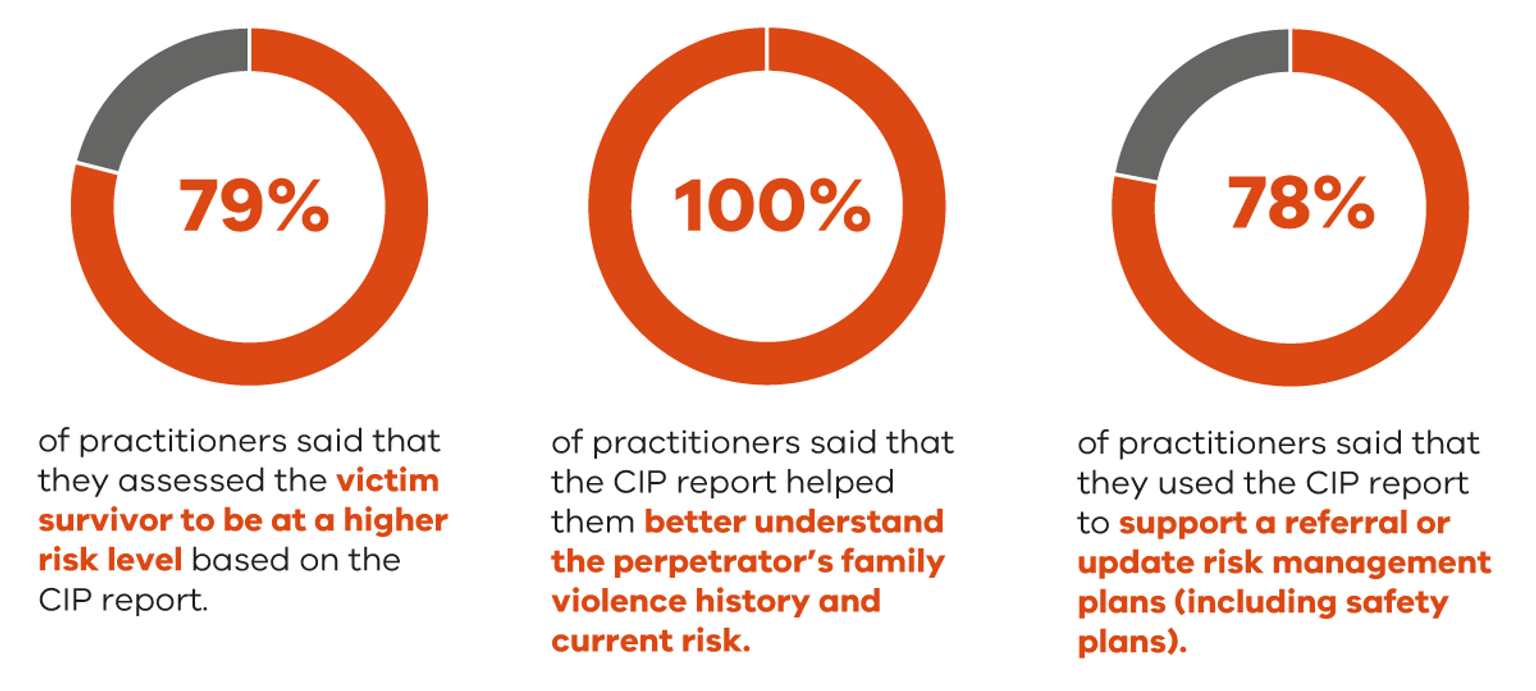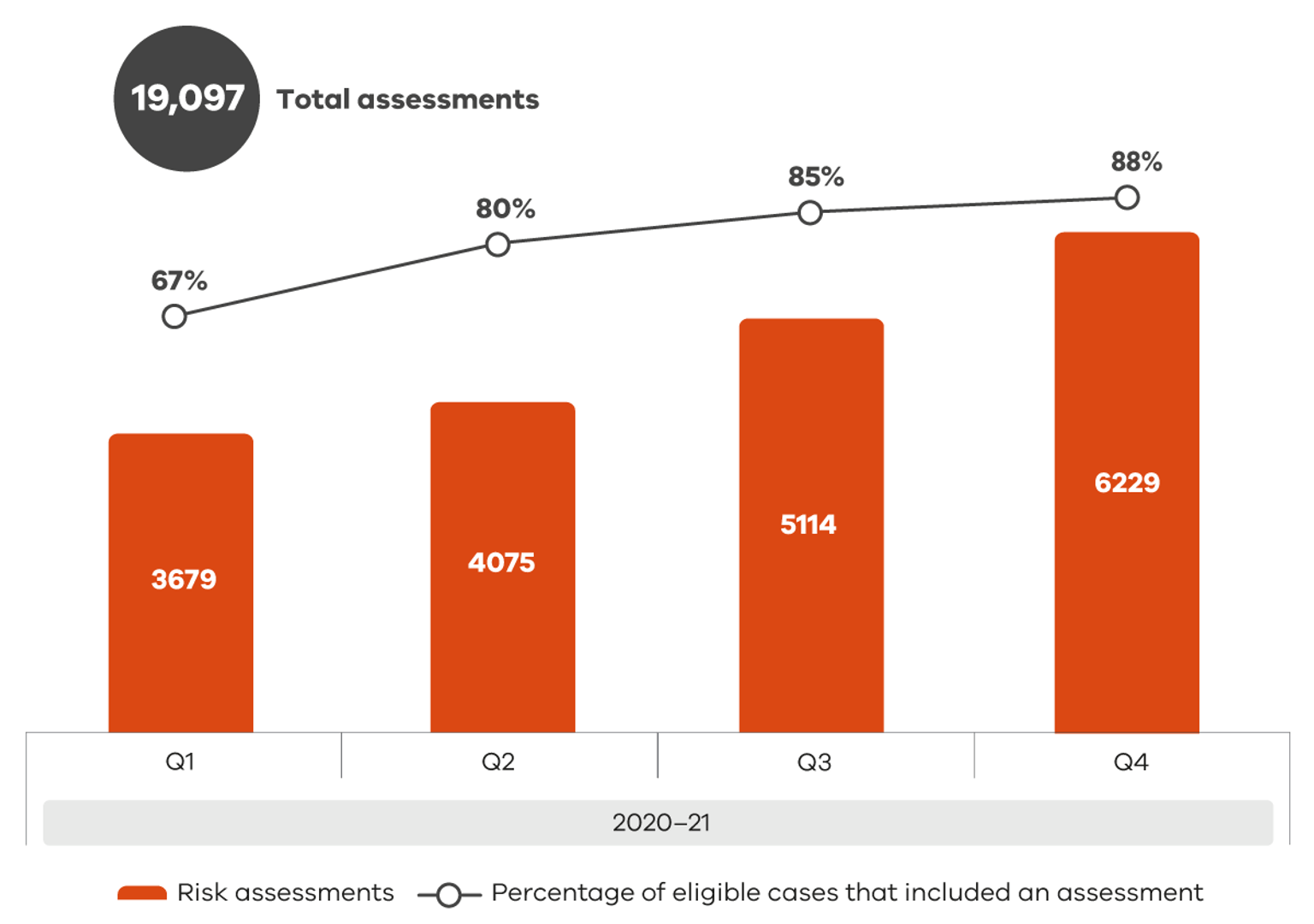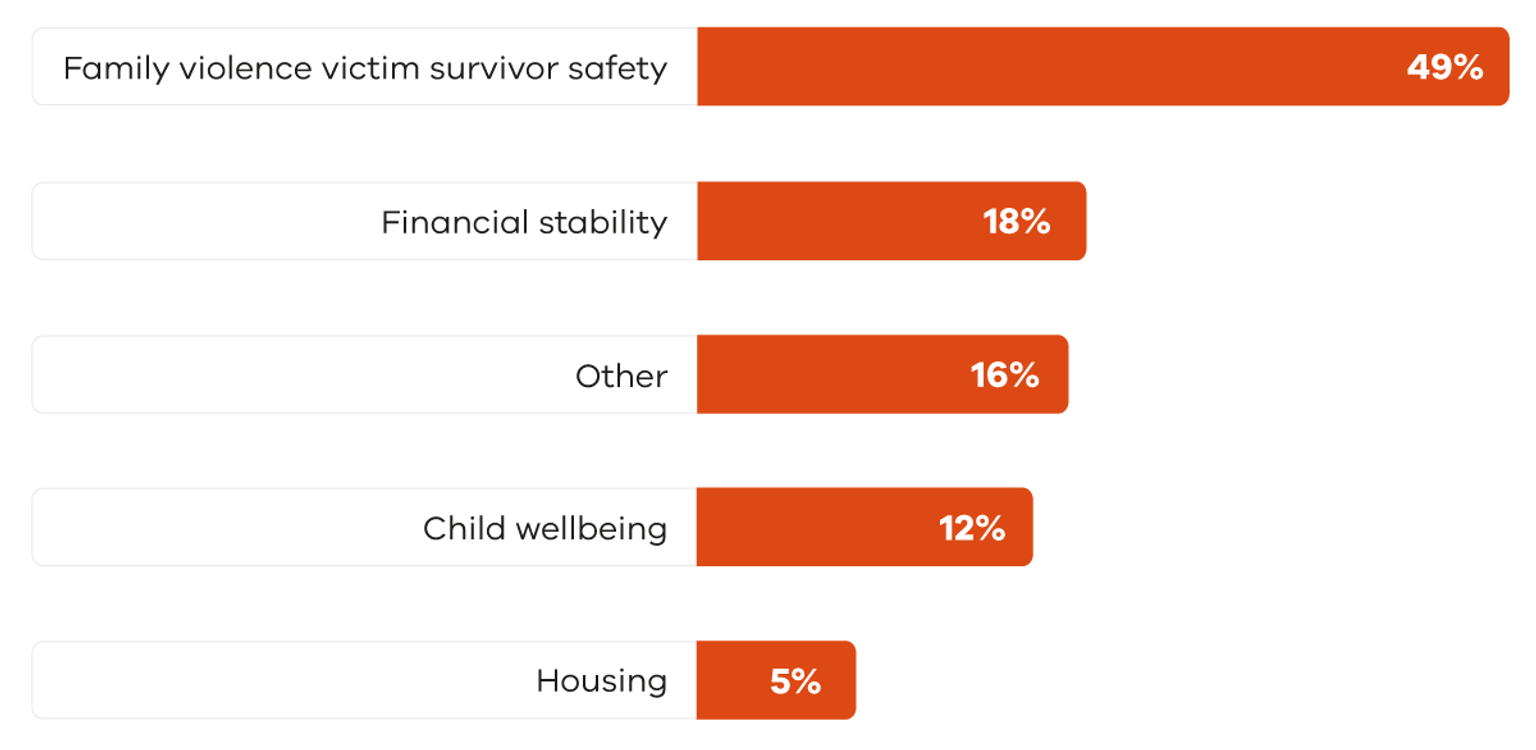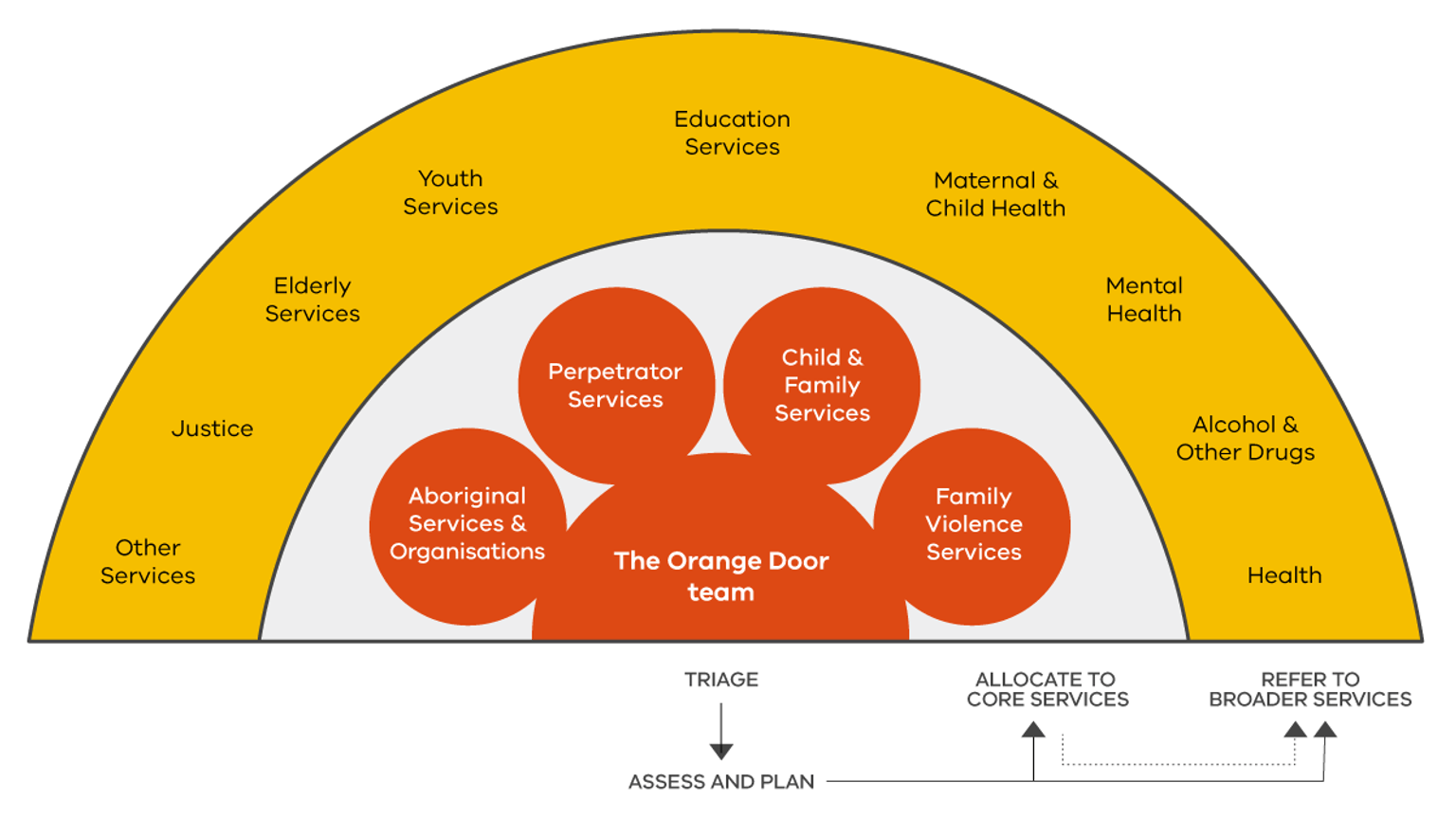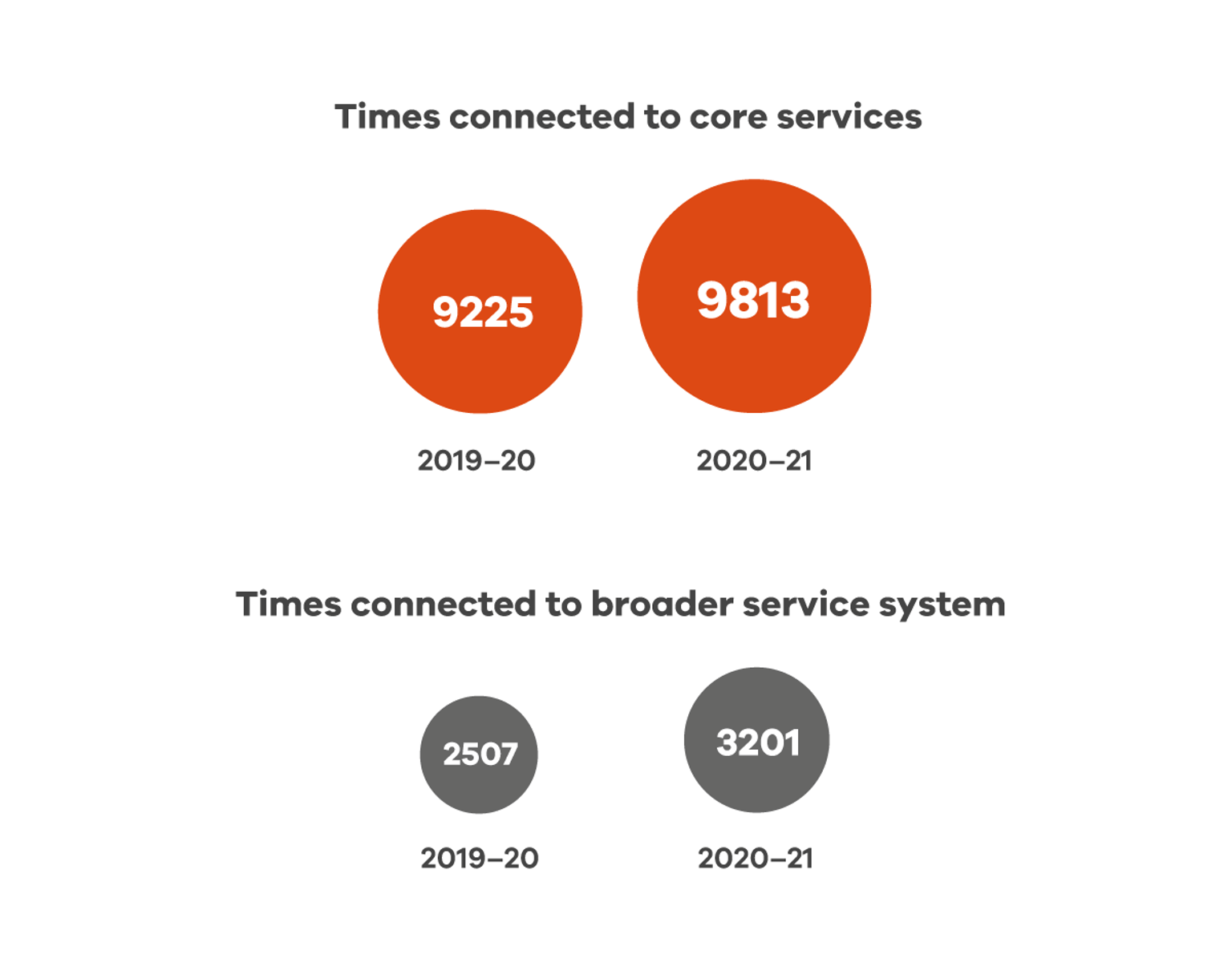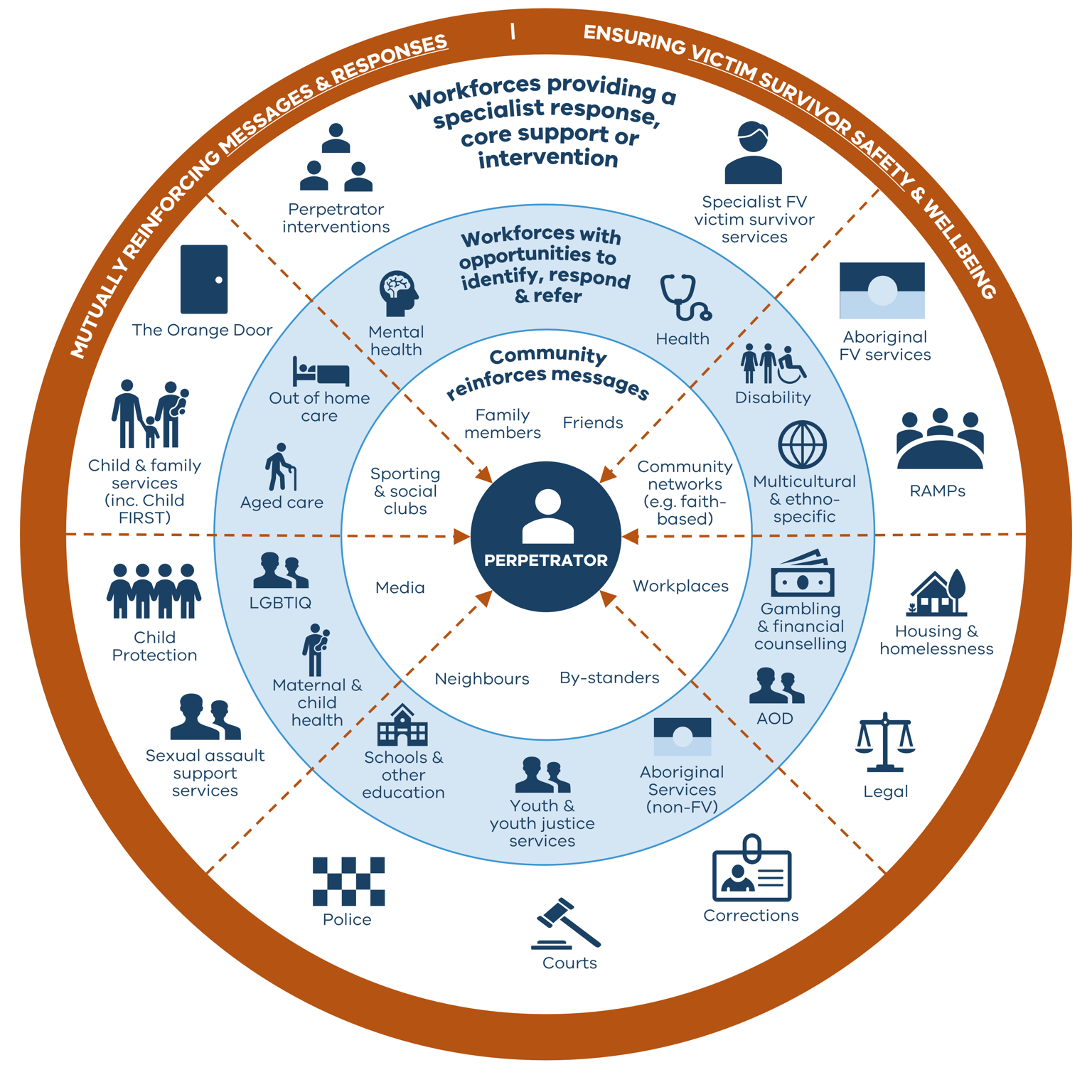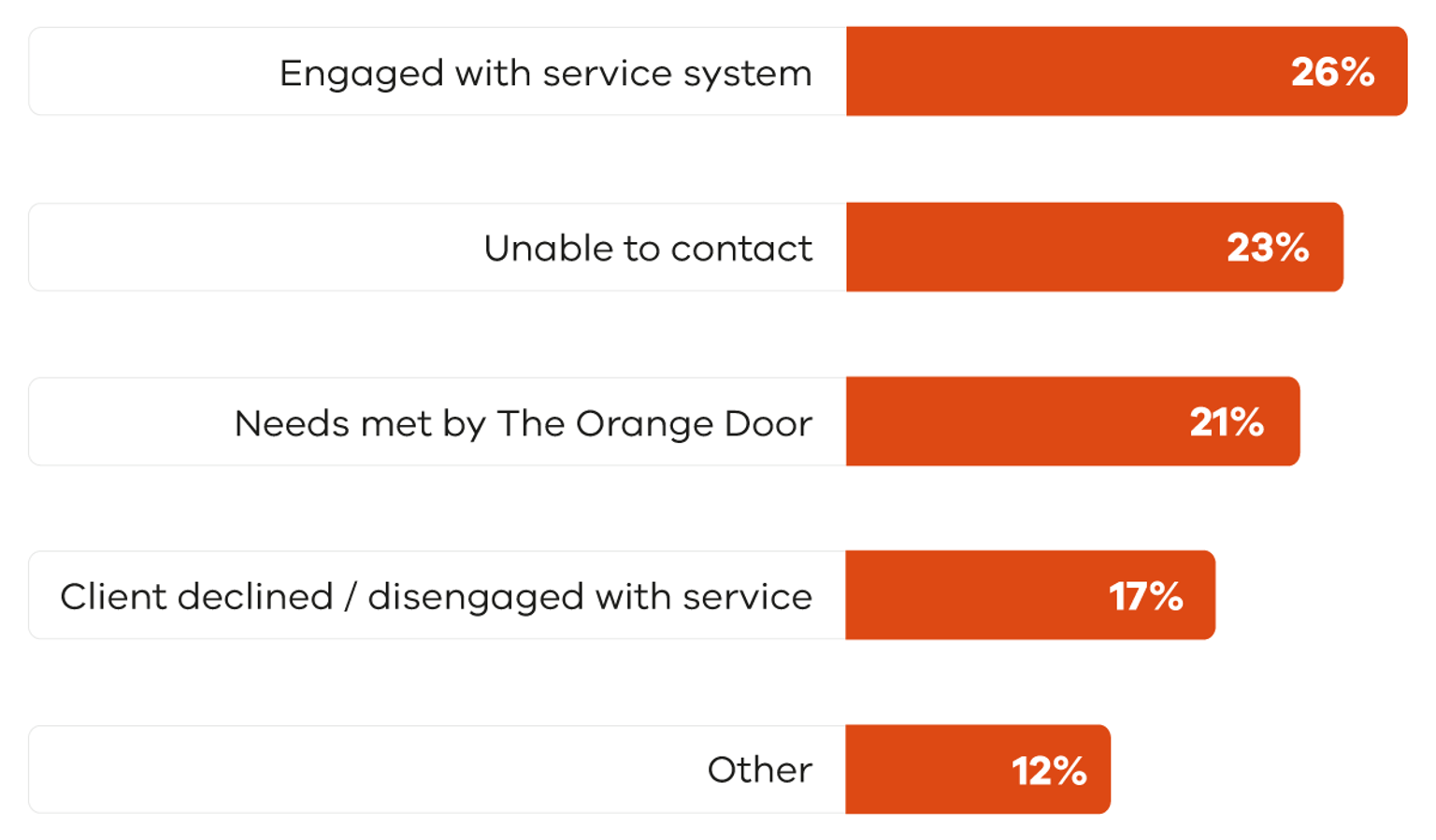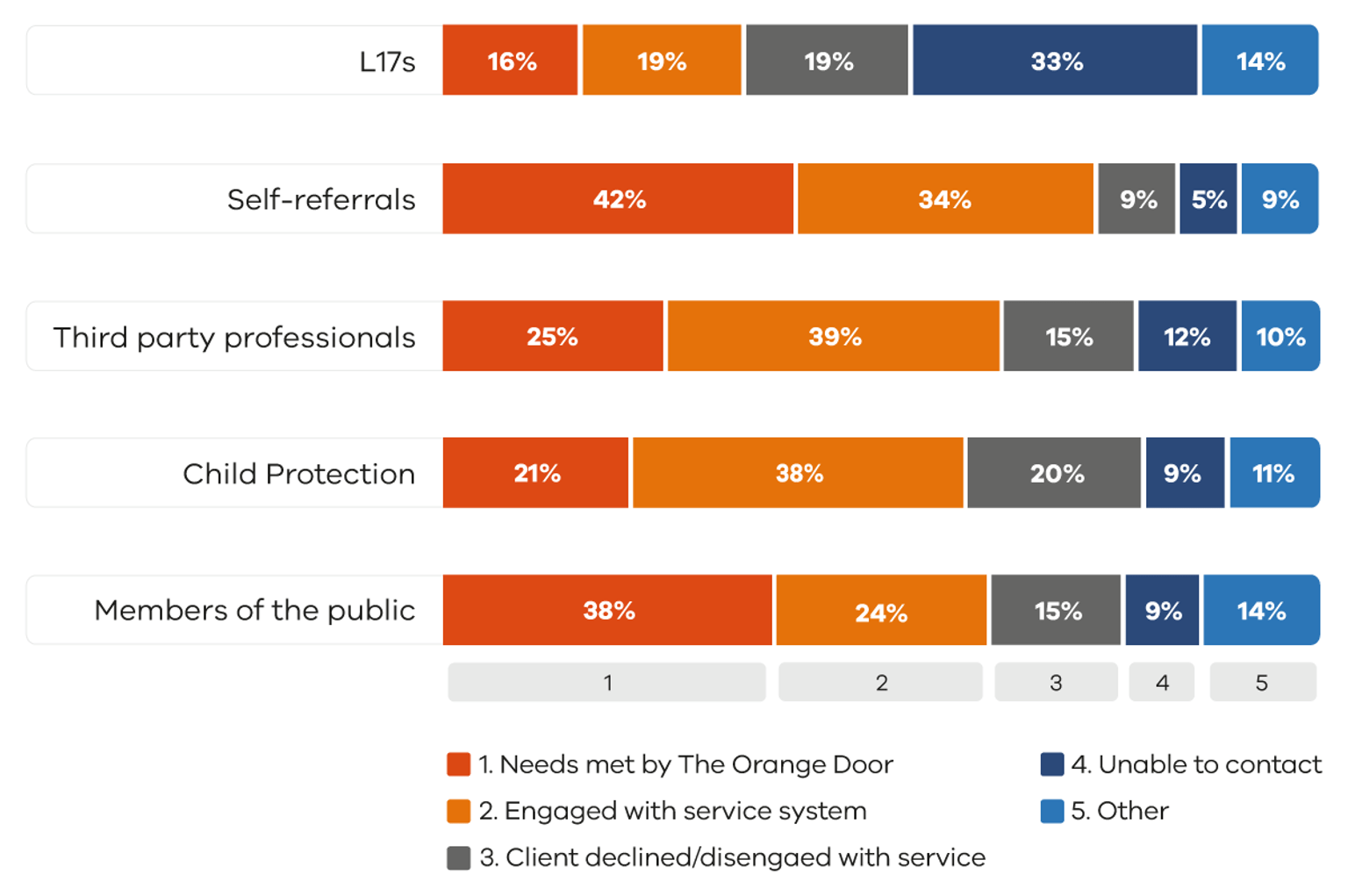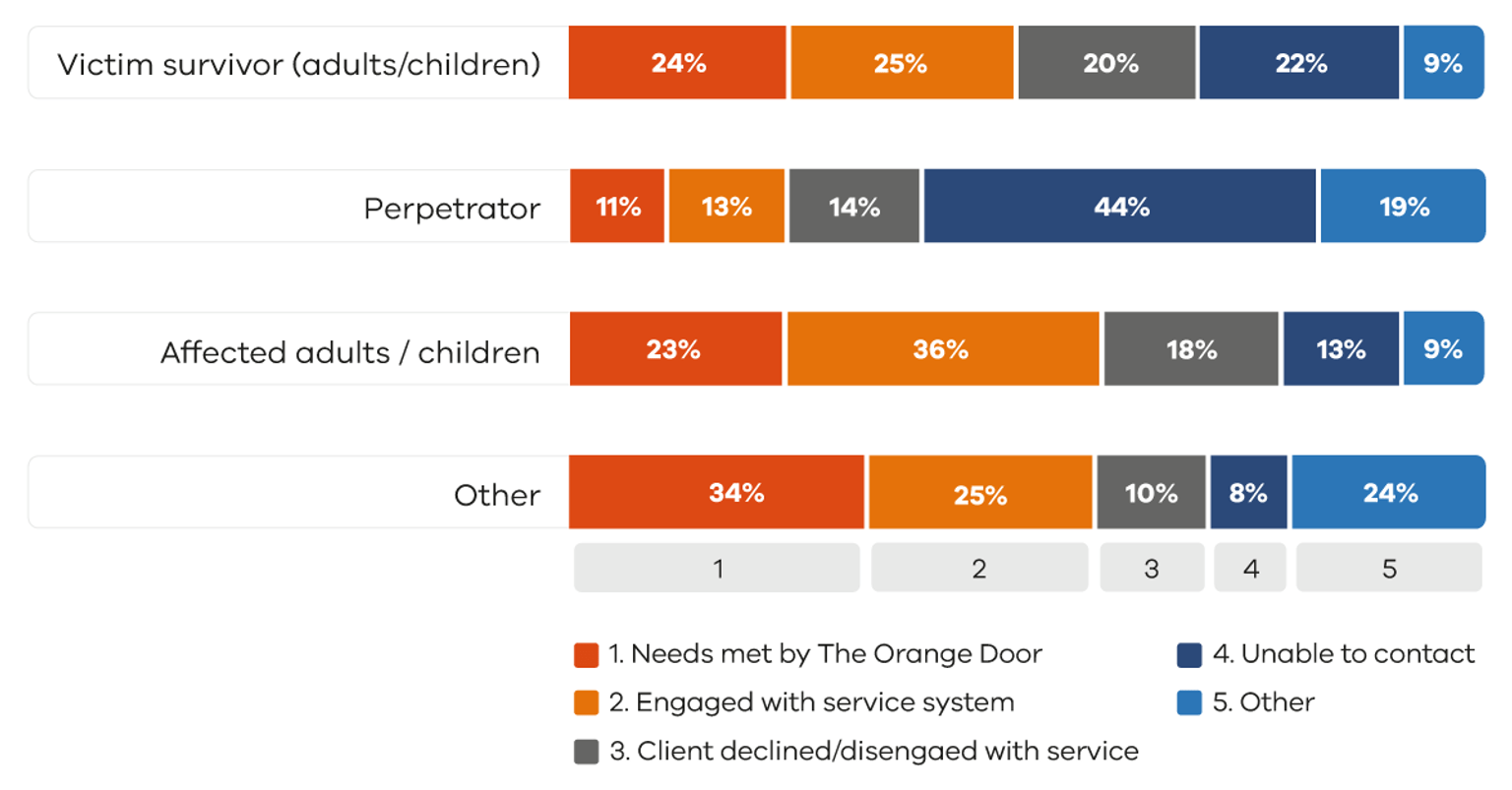- Published by:
- Family Safety Victoria
- Date:
- 6 May 2022
Aboriginal acknowledgement
The Victorian Government proudly acknowledges Victorian Aboriginal people as the First Peoples and Traditional Owners and custodians of the land and water on which we rely. We acknowledge and respect that Aboriginal communities are steeped in traditions and customs built on an incredibly disciplined social and cultural order. This social and cultural order has sustained up to 50,000 years of existence. We acknowledge the ongoing leadership role of the Aboriginal community in addressing and preventing family violence and join with our First Peoples to eliminate family violence from all communities.
Foreword
Foreword from the Chief Executive Officer
This 2020-21 Annual Report continues to demonstrate our shared commitment in Victoria to delivering a service system that is connected, inclusive and works together to help keep adults, children, and families safe.
The evidence for the effectiveness of this innovative model became increasingly apparent through the year as we navigated dealing with the impact of the coronavirus (COVID-19) pandemic, while keeping the needs of victim survivors, children and families at the forefront of our work.
The pandemic affected people in multiple ways, and it was only by working closely with our community-based partners that we were able to alleviate many of its negative impacts, whilst also tackling the increased risks of violence, abuse and neglect at home.
This report shows the benefit of local collaboration between specialist family violence services, perpetrator services, children and family services, Aboriginal services, and targeted services for multi-cultural communities.
Over the year, 66,309 referrals were received by The Orange Door network, a 30.4 per cent increase compared to the previous year. Over half of the referrals received (34,437) included at least one child. Since first opening in 2018, The Orange Door network has assisted more than 216,000 Victorians, including more than 87,000 children, access immediate and longer term supports that range from crisis support, practical help, advocacy and counselling in the community.
We want to make sure there is no wrong door when someone needs help or support. There are now several ways that people can access the network of services, based on their individual needs. This includes by telephone or email, dropping in to the primary site, through outreach support or getting help from The Orange Door network in other community, health or justice services. Some community services including legal, financial and housing services also provide support through The Orange Door network.
Whilst we prioritised maximising the accessibility of the services available, we also maintained our focus on the important task of developing and opening three additional The Orange Door primary sites. By the end of 2020-21, The Orange Door network operated across the eight areas Barwon, Inner Gippsland, North Eastern Melbourne, Bayside Peninsula, Mallee, Central Highlands, Loddon and Goulburn.
We also remain on track to ensure that by the end of 2022, all areas will have access to this integrated service response in our communities. Effective implementation planning through the year meant that Inner Eastern Melbourne, Ovens Murray, Southern Melbourne, Outer Gippsland and Hume Moreland are all now operational, and Western Melbourne, Brimbank Melton, Wimmera South West and Outer Eastern Melbourne will commence by the end of 2022.
We could not have achieved this alone, and I thank each one of our partner organisations for your commitment to ensure that we continued delivering services to people who needed support through these unprecedented times.
Eleri Butler
CEO, Family Safety Victoria
Language in report
Family violence includes physical, sexual, emotional, psychological and economic abuse, as well as coercion and control or domination that causes the family member to feel fear for the safety or wellbeing of themselves or another person, and the exposure of these behaviours, or the effects of them, to a child.
There are many relationships in which family violence can occur. These include between spouses or domestic partners and in other intimate personal relationships such as parent–child, child–parent, with elders, siblings and other relatives, and between extended families, kinship networks and in family-like or carer relationships.
This report adopts gendered language in recognition that most (but not all) victims of family violence are women, most (but not all) perpetrators are men, and that violence perpetrated by a man is the most prevalent form of family violence. It recognises that the causes of family violence are complex and include gender inequality and community attitudes towards the roles of women and men in society.
Throughout this report, references are made to ‘women, children and young people’ in relation to people who are victim survivors of, or at risk of, family violence, and to ‘men’ in relation to people perpetrating violence. When we use the term perpetrator, we are referring to adults, not adolescents who use violence in the home who need a developmentally appropriate response. However, it is recognised that some individuals and communities, including Aboriginal communities, prefer the term ‘person using family violence’ and that terminology needs to be tailored in different practice settings to support engagement.
At the same time, there is a recognition that men and boys might also experience family violence in their own right, that perpetrators are not always men, and that family violence occurs in relationships other than male–female intimate partner relationships. Victims of these forms of family violence face additional barriers to getting help because these other forms of violence are often not recognised or understood. The Orange Door aims to respond to, and link effectively with, services that respond to family violence in all its forms.
The word family has many different meanings. Our use of the word ‘families’ is all-encompassing and acknowledges the variety of relationships and structures that can make up a family unit and the range of ways family violence can be experienced, including through family-like or carer relationships.
Throughout this report, the term Aboriginal is used to refer to both Aboriginal and Torres Strait Islander peoples.
Diversity within the Victorian population is increasing as people express multiple forms of identity and belonging. Diverse groups can experience additional risk of family violence and particular barriers to seeking safety and justice. Intersectionality describes how characteristics such as gender, ethnicity, ability, sexual orientation, gender identity, religion or age, can interact on multiple levels to create overlapping forms of discrimination and power imbalances which compounds the risk of experiencing family violence.
Introduction
A key recommendation of the Royal Commission into Family Violence was to establish a network of Support and Safety Hubs, now known as The Orange Door network, across Victoria. The Orange Door network is an integral part of the family violence and family services systems. It provides an entry point into the continuum of services that aims to ensure there is no wrong door to access high quality, consistent and effective support for children, young people and families in communities.
The significant work undertaken across government and the community sector, specifically our partner agencies, to build networks of safety and to connect services has been central to the successful implementation of The Orange Door network. There continues to be an enormous commitment and effort by The Orange Door network workforce and partner agencies delivering this new service model.
The coronavirus (COVID-19) pandemic response had a major impact on The Orange Door network during the first half of 2020-21 and required Family Safety Victoria (FSV) and our partners to prioritise service delivery and related critical activities to help keep people safe. Essential intake, risk and needs assessment and safety planning was increasingly delivered over the phone or virtually during physical distancing/community containment periods. Face-to-face services continued to be provided for people assessed as high risk or with high support needs where it was gauged that other means of supporting and providing a service were insufficient or unavailable. Coordination was maintained with workforces more likely to be in contact with families impacted by family violence and in need of child and family support during the pandemic, such as primary healthcare workforces.
Work to progress establishment of The Orange Door network continued throughout this period, with The Orange Door in Loddon and Central Highlands commencing operations in October 2020 and Goulburn commencing in April 2021. Beyond the reporting period of this report, a further 5 areas have since commenced with all remaining areas due to have a new site commence in 2022.
The VAGO performance audit conducted in 2019 made 9 recommendations focusing on project planning, management and governance, operational delivery, support for integrated practice, performance reporting and oversight, and continuous improvement. Several actions to implement VAGO’s recommendations commenced in 2020-21.
Data considerations
Sharing experiences and data from the third year of service delivery
This annual report uses service provision data to explain how The Orange Door network supported people in the 2020-21 financial year. Information and data have been collected from the Client Relationship Management (CRM) system used by The Orange Door network. This system continues to be enhanced to provide data to inform service delivery, policy and improvements.
As data collection and reporting processes continue to be strengthened, we will gain a clearer picture of the experience of accessing The Orange Door network and the services people need to be safe and supported.
Presentation of the data
In many cases, the data is broken down by quarters:
- Quarter 1 (July – September 2020)
- Quarter 2 (October – December 2020)
- Quarter 3 (January – March 2021)
- Quarter 4 (April – June 2021).
Throughout the report these are referred to as Q1, Q2, Q3 and Q4. Data extracted from the CRM for this report was extracted in December 2021, which allows for most of the information from 2020-21 to be finalised (noting that this may not occur until a case is closed). In some instances, this report provides comparisons between data from 2018-19 and 2019-20.
Inherent limitations
It should be noted that 2018-19 data does not reflect a full year of operations for the North East Melbourne and Inner Gippsland areas, which commenced in July 2018 and November 2018 respectively. Similarly, the current reporting period of this report (2020-21) does not reflect a full year of operations for the Central Highlands (October 2020), Loddon (October 2020) and Goulburn (April 2021) areas. Accordingly, comparisons involving these areas must be treated with caution. Given the dynamic nature of the CRM, data used for comparative purposes from 2018-19 and 2019-20 was extracted in December 2021 to allow for a more accurate reflection of any updates to the data after the relevant annual reports for those years were produced. Therefore, the figures may be slightly different to those that were published in previous annual reports.
It is also important to note that due to the staggered nature of the implementation and commencement of Orange Door sites in new areas, the opening of new sites results in additional capacity across the network thereby contributing to growth in overall service delivery. This is particularly noticeable when comparing to a previous period when fewer sites were in operation.
About The Orange Door
Thomas and Nadja: a holistic family response to address family violence and child wellbeing needs
The Orange Door works in an integrated way with families, collaborating with external agencies to ensure that risk-relevant information is shared and safety is prioritised for everyone involved.
When Thomas rang The Orange Door asking for support, he said he was very stressed due to overcrowding in his home. The Orange Door practitioner engaged with Thomas and learnt that he lived with his partner Nadja, their two primary school aged children Michael and Junior. Thomas was seeking financial support as he was unable to work due to ongoing physical and mental health issues. Thomas stated that he and Nadja felt unsafe as their neighbours were threatening them.
During the call, The Orange Door practitioner spoke with Nadja and her responses to questions indicated that she was unable to speak freely. The practitioner completed safety planning with Thomas and Nadja including confirming that they would both call police if they felt unsafe. The Orange Door practitioner arranged for Thomas and Nadja to attend The Orange Door in person to collect a mobile phone as part of the safety plan so that they would both have a phone to call police.
The Orange Door also undertook a review of service history which indicated a history of family violence from Thomas towards Nadja. A decision was made for another Orange Door practitioner to proactively engage Nadja and her children whilst working closely with the practitioner who would continue to engage with Thomas.
Later that day, Nadja attended The Orange Door in person whilst Michael and Junior were at school. Nadja disclosed that Thomas was very controlling of her, verbally abusive and rarely let her leave the house. Nadja was worried about the effect of Thomas’ abusive behaviour on her children, which had escalated during the COVID-19 lockdown.
The Orange Door completed assessments and safety planning for Nadja, Michael and Junior and provided financial support. Information sharing with the children’s school raised concerns about the lack of engagement, particularly with online learning during the COVID-19 pandemic.
The Orange Door practitioner completed a risk consultation with Child Protection. Child Protection shared that they had an open case for the family and would be undertaking a home visit with Thomas and Nadja and would encourage them to continue to engage with The Orange Door. The Orange Door spoke with Thomas the next day and completed safety planning with him – he said he had been yelling at his family and that he had missed an appointment for his mental health. With Thomas’ consent, The Orange Door practitioner contacted the mental health professional and arranged for a telephone appointment that afternoon.
Thomas contacted The Orange Door during the Child Protection home visit and said that Child Protection wanted him to leave the family home. The Orange Door practitioner arranged crisis accommodation for Thomas and arranged mental health support for him whilst in the accommodation. With Thomas’ consent, The Orange Door practitioner also referred Thomas to a housing service and a family violence behaviour change program.
Knowing that Thomas had the supports in place he required, Nadja applied for an Intervention Order to ensure that Thomas knew he could not return to the home. Child Protection worked with Michael and Junior’s school to ensure they were supported to return to school and received support from the school counsellor. Nadja, Michael and Junior were referred to a program to assist them to establish safety, rebuild relationships and move forward with their lives after violence.
*Not their real names
What is The Orange Door network and how does it work?
The Orange Door network is for adults, children and young people who are at risk of experiencing or have experienced family violence, and for families who need support with the development and wellbeing needs of their children and young people. It assesses and responds to a person’s needs and risk, and connects people to family violence services, Aboriginal Community Controlled Organisations (ACCOs), family services and services for perpetrators (collectively referred to as ‘core services’).
The Orange Door network also connects people to a broader range of services such as mental health or housing support. Practitioners support people to navigate the service system and address the spectrum of needs that might be identified. The Orange Door network is designed to avoid the person having to ‘re-tell their story’ by providing an integrated service response.
How The Orange Door network is set up to support people
The Orange Door network provides a visible entry point in each Orange Door area for adults, children and young people who are at risk of experiencing or have experienced family violence, and for families who need support with the development and wellbeing needs of their children and young people. Practitioners work in interdisciplinary teams to ensure the required specialisations can respond to the person/family, while working together to provide an integrated assessment of risk and needs. The Orange Door network facilitates strong connections into local community services to support clients getting the help they need from other services.
The Orange Door network includes a range of options to support people seeking assistance in their local community. This is made possible via the inclusion of access points, outpost sites and providing outreach, in addition to the primary site. The Orange Door network can also be accessed via phone, email or in-person. These access networks are vital in providing accessible services for clients and communities across Victoria.
The Orange Door network’s primary premises are located in Ballarat, Bendigo, Frankston, Geelong, Heidelberg, Morwell, Mildura and Shepparton. Access Points provide physical access to The Orange Door network from alternative locations, enhancing accessibility across a geographic area or for specific communities. In 2020-21, Access Points were operational in Bacchus Marsh, Colac, Prahran and Swan Hill. Access planning is underway in all DFFH areas with access networks expanding across the state in 2021-22.
Aboriginal Access Points are also being established as a complementary service model to work alongside The Orange Door network, providing a culturally safe referral pathway for Aboriginal people impacted by family violence. The Aboriginal Access Points service model was endorsed for implementation by the Dhelk Dja members at the Dhelk Dja Partnership Forum in May 2021. A targeted Expression of Interest process will commence in 2021-22 to establish the three Aboriginal partner agencies in Mallee, Bayside Peninsula and Barwon providing additional options for Aboriginal people to access services and support.
Who works at The Orange Door network?
The Orange Door network workforce is comprised of staff from Community Services, Health Services and ACCOs with specialisations in family violence and/or child and family services. In addition, the Community Based Child Protection team is part of The Orange Door workforce in conjunction with a team of staff employed by FSV. The workforce includes:
- Specialist Practitioners: The expertise of different practitioners is drawn on to provide an interdisciplinary approach with specialists in family violence, child and family services, ACCOs and perpetrator services working together in The Orange Door network.
- Practice leadership: practice leadership is provided to the practitioners to support high quality and culturally safe service delivery through practice leadership roles such as: Team Leader, Aboriginal Practice Leader, Advanced Family Violence Practice Leader, Integrated Practice Leader, Children and Young People’s Practice Leader, Advanced Family Violence (Men’s) Practice Leader and Community Based Senior Child Protection Practitioners.
- Operational support: The Orange Door network teams are supported by a team from FSV that includes a Manager, Service System Navigator, Strategic Planning and Reporting Officer, Operational Support Officers, Client Support Officers and administrative support staff.
The total workforce headcount for the eight Orange Door areas that were operational at June 2021 was 650 Full Time Equivalent (FTE) positions. This was up from 290 FTE positions in 2019-20, an increase of 124%. This growth in headcount was due to the expansion of the Orange Door network into three new operational areas and expansion of capacity at existing sites to meet demand. As at December 2021, 82% of the 650 FTE positions were filled and this comprised a wide range of different roles (Figure 1 below), noting that this is based on data from outside the reporting period of this report.
FSV continues to work collaboratively with peak and service partners to strengthen workforce capability in culturally responsive, skilled and integrated practice, including work to progress delivery of Aboriginal cultural safety training to all staff, and a new induction and learning program. The Orange Door Aboriginal Inclusion Action Plan plays an important role in this. This aims to build workforce capability with a view to providing services that are culturally safe and accessible for Aboriginal people.
Referrals and access
How are people accessing The Orange Door network for assistance?
The Orange Door network aims to be accessible, safe, and welcoming to people, providing quick and simple access to support. In 2020-21, The Orange Door network received 66,309 referrals, a 30.4% increase compared to 2019-20. Over half of the referrals received (34,437) included at least one child.
The increase in referrals was mainly due to the expansion of the Orange Door network into the new operational areas of Central Highlands, Loddon and Goulburn in 2020-21 (as demonstrated in Figure 2). However, the pre-existing Orange Door areas (Bayside Peninsula, Barwon, Mallee, Inner Gippsland and North East Melbourne) also experienced an increase in referrals from 50,860 in 2019-20 to 55,011 in 2020-21 (8.2%). When comparing over a longer three-year time period, the number of referrals to these pre-existing areas increased by 33.7%, from a starting point of 41,135 in 2018-19.
Referrals to the Orange Door network come from a range of sources, including police reports, self-referrals, Child Protection, other professional sources and members of the public. Figure 3 provides the percentage contribution of these sources towards total referrals across the network, including quarterly trend over the last year.
Referrals that come directly from Victoria Police when there has been a report of an incident of family violence (known as ‘L17s’) are provided through a dedicated online portal (the L17 portal). In 2020-21, the most common way people accessed The Orange Door network was through police referral reports, making up 57.3 per cent of all referrals.
People do not need a professional referral to access The Orange Door network. Individuals and families who need support can make direct contact themselves, a ‘self-referral’. These self-referrals include contact via phone, email or attending The Orange Door.
In 2020‑21, self-referrals comprised 17.3% of all referrals, up from 17.0% in 2019-20 and 13.2% in 2018-19 (4.1 percentage point increase since 2018-19). This suggests that the number of people proactively seeking help is increasing and this may be the result of more visible and accessible entry points brought about by The Orange Door network.
Referrals of individuals and families can also be made by a range of professionals (including Child Protection) or members of the community. Professionals and members of the community can also contact The Orange Door network for information and advice where there are concerns for the safety of an adult or child and/or the wellbeing of a child.
How does the community presence of The Orange Door network support safe and easy access?
The Orange Door network is designed to be a safe and accessible community service, to make it easier for people seeking help for family violence or help with the wellbeing of children, young people and their families. People can contact The Orange Door network in ways that are convenient, safe and accessible for them, including through telephone, email and in person.
People who make direct contact to The Orange Door themselves (self-referral) generally do so via telephone (88.5%) as do people making contact on behalf of someone they know (89.9%). Referrals received from professionals (excluding the Family Violence reports from police) are mostly received via email (62.1%) or telephone (37.0%). Across all referral types, excluding the L17 portal, 54.2% of all referrals are received via telephone (Figure 4).
Each area has a toll-free telephone number and direct email address to facilitate easy contact. The Orange Door network website has a service finder function to support people to find the contact details for The Orange Door network in their area, or relevant services in areas where The Orange Door network is yet to be established. Information contained on The Orange Door website is accessible in 51 different languages. In 2020-21, the website was visited over 197,000 times by almost 122,000 people. This represented a 52% increase in visits and a 46% increase in users compared to 2019-20.
The physical premises of The Orange Door network have been established in locations that are central to the local community and public transport. The COVID-19 pandemic continued to have a significant impact on people’s access to the physical premises of The Orange Door network in 2020-21. This can be seen across all Orange Door areas which experienced a sharp decline in the number of walk-ins since the pandemic started (Figure 5). This decline occurred in spite of Victoria’s public health directive that people were always able to leave their homes to escape family violence risk or harm.
In 2020-21, a total of 865 individuals and families (1.3%) presented to The Orange Door network in person (walk-ins) to seek support for themselves or someone else, a 65.0% decrease compared to 2019-20. For the latter half of 2020-21 as lockdowns eased somewhat, the number of walk-ins began to recover but not to pre-pandemic levels.
Further analysis indicates that, while walk-ins to the five initial Orange Door areas remained low for a prolonged period over 2020 and 2021, self-referrals via phone calls to the network started to increase after March 2020. As a result, the overall number of self-referrals rebounded to a level similar to that seen before the pandemic by October 2020.
People provided with a response
Who is accessing The Orange Door network for assistance?
The Orange Door network aims to be inclusive, responsive, and accessible for individuals of any age, gender, ability, sex, sexual orientation, ethnicity, culture, or religion. Upon full implementation across all Victorian areas, The Orange Door network will be available to all Victorians.
The Orange Door network recognises that people can face additional barriers to getting the help they need due to systemic or structural discrimination. The Orange Door network will ensure that everyone who needs help is able to access the right support at the right time, in alignment to the Everybody Matters: Inclusion and Equity Statement and The Orange Door Inclusion Action Plan.
Everybody Matters: Inclusion and Equity Statement is a ten-year commitment that supports Ending Family Violence: Victoria’s Plan for Change to build an inclusive, non-discriminatory, safe, responsive, and accountable family violence system for all Victorians.
The statement includes a call for everybody to:
- act as champions for diversity
- challenge the current system
- strive for change that delivers choice for all which includes workers, service organisation leaders and those with lived experience.
More information about the statement can be found on the Victorian Government website.
The Orange Door Inclusion Action Plan is a two-year plan to embed inclusion, access, and equity in the services and policies of The Orange Door network. Developed in 2019-20 with partner agencies and released in 2021, it sets out how The Orange Door network will ensure services are accessible for all clients and offer supports tailored to individual needs and experiences. The Inclusion Action Plan outlines a series of actions aimed at achieving inclusion through the physical environment, leadership, communication, training, and connection with local communities.
How many people has The Orange Door network sought to support?
The Orange Door network provides a range of responses to individuals and families referred through for support, from the assessment of risk and need, development of safety plans, provision of an immediate crisis response, access to brokerage and connection to other services for ongoing support such as family violence case management and family services.
In 2020-21, 76,998 people including 30,806 children and young people (including unborn children) were referred to The Orange Door network and provided with a response[1]. Compared to 2019-20, this represented a 31.1% increase in the number of people and a 37.0% increase in the number of children and young people provided with a response. Children and young people represented 39.8% of all people provided with a response in 2020-21, slightly up from 38.0% in 2019-20. This reflects a growth in referrals to The Orange Door over this same time period.
Individuals and families can seek assistance from The Orange Door network as many times as they need. In 2020-21, 23.0% of people who received a response from The Orange Door network were referred or sought assistance two or more times during the financial year. Both adults and children and young people displayed a similar pattern in the number of times they were referred or sought support from The Orange Door network (Figure 6).
When comparing service access in 2020-21 with that in previous years (May 2018 to June 2020), 31.1% of people who received a response in 2020-21 had accessed the network in previous years.
Similar to the methods used by individuals and families when making initial contact with The Orange Door network, responses from practitioners may be provided via face to face (in person or online), telephone, email or a combination of these, depending on the person’s preferences and what is safe to do in the specific circumstances. By providing a comprehensive service response to individuals, families and children and young people, The Orange Door network aims to address people’s needs and prevent them needing to tell their story more than once.
Working with people from diverse communities
The Orange Door network is welcoming to people of any age, gender, ability, sex, sexuality, ethnicity, culture or religion. People from diverse communities are offered safe service responses through The Orange Door network where their cultural and religious and other preferences and specific needs are respected.
In 2020-21, over half of all adults who were provided a response from The Orange Door network identified as female (56.6%) compared to a lower proportion who identified as male (40.9%). For children and young people, the proportion who identified as female or male were more equal. For a small percentage of people (3.9%), their gender was recorded as unknown. This reflected an improvement in recording of gender as the percentage of people where gender was recorded as unknown was larger in 2019-20 (11.4%). This is a marked improvement in data collection and will continue to be an area for improvement.
While the data about clients’ disability, country of birth, language spoken at home, sexual orientation, and gender identity is improving, it is still not sufficiently robust to provide an accurate reflection of the clients seen by The Orange Door network, or for reporting purposes. Data relating to client demographics remains an area of focus. Enhancements to the Orange Door network CRM in the next financial year will focus on increasing the quality and quantity of data collection on diverse communities with an emphasis on CALD and LGBTIQA+ communities and clients with a disability. There will be an emphasis in 2021-22 on making important fields mandatory and prompting users to review and edit this information when closing a case, as well as supporting workforce capability to ask identity questions. This will be monitored as part of the two-year Inclusion Action Plan.
The Inclusion Action Plan outlines a series of baseline actions aimed at achieving inclusion through the physical environment, leadership, communication, training, and connection. In addition to this, as part of the Inclusion Action Plan, and to support the frontline workforce in The Orange Door network, a range of capacity development initiatives are being planned and conducted across the network. These initiatives include building and embedding culturally responsive practice, supporting the workforce to engage with language and translation services and a pilot training and mentoring program to support LGBTIQA+ understanding and capacity across The Orange Door network. Following these initiatives, further work will be undertaken to replicate and scale-up effective elements of the training.
The Bandara Family: being accessible to everyone in our community
The Orange Door can be accessed by anyone in the community seeking assistance in relation to the wellbeing of children and young people or for family violence. Practitioners can tailor their approach to ensure that people of any ability, culture, age, gender, sex, sexuality, religion or ethnicity are able to fully access the service.
The Bandara family attended The Orange Door in person seeking financial assistance to buy food and other items. The mother, Dayani and father, Fernando were unable to access income support as they were seeking asylum in Australia due to religious persecution in their country of origin and were in the appeal stages of their application for a protection visa. The family were being supported by a number of agencies, including health and culturally specific organisations.
Practitioners spoke with Dayani and Fernando utilising interpreters and their four children were supervised by other Orange Door practitioners whilst this occurred. Dayani shared that there had been a recent family violence incident and Fernando was served with a limited intervention order, with conditions not to further perpetrate family violence. When they attended court, they had been told about The Orange Door.
Dayani wished to remain in the relationship and the family home and was concerned for Fernando’s wellbeing. The Orange Door practitioner completed a safety plan with Dayani, which included advising her of her options for support whilst experiencing family violence as well as strategies in the event of another incident of family violence. Dayani declined family violence support as she was more comfortable with the therapeutic support she received via her culturally specific organisation. With Dayani’s consent, The Orange Door contacted the organisation and shared Dayani’s safety plan and The Orange Door’s family violence assessment.
During the assessment with Fernando, he discussed his use of violence, lack of employment, depression and substance misuse. Fernando acknowledged his values and belief systems had shaped his choice to use violence and the family dynamics. The Orange Door practitioner referred Fernando to a Southeast Asian men’s behaviour change program which addresses cultural values and issues relating to migration that may be contributing factors in his use of violence. Fernando also agreed to engage in a drug and alcohol service. The Orange Door practitioner and Fernando contacted the service together and completed a preliminary assessment and arranged a follow up appointment in two days.
The Orange Door practitioners provided material aid to the Bandara family via brokerage funding and encouraged the family to reconnect if they required.
The Orange Door practitioners consulted with each other and shared concerns for the families’ intersectional needs, indicative through the physical presentation of the family and the overall emotional wellbeing of the family, which was significantly impacted by their history of trauma and lack of access to money. Dayani and Fernando were referred to Family Services who stated that they would undertake a home visit that week. The Family Services worker undertook to coordinate a case conference with the professionals involved after their home visit and continued to monitor and assess the family violence risk.
*Not their real names
Supporting Aboriginal self-determination
Aboriginal Community Controlled Organisations are critical partners in The Orange Door network. They receive funding to employ an Aboriginal Practice Leader and Aboriginal hub practitioners to ensure that Aboriginal people receive a culturally safe response. In addition, ACCOs support the establishment of the Aboriginal Advisory Group which involves community members, the Dhelk Dja coordinators and other ACCOs to ensure a culturally safe response and strong connections with local services.
In 2019-20, additional state-wide funding was provided to ACCOs enabling them to expand their Orange Door practitioner workforce, increasing from $1.8 million in 2019-20 to $5.4 million in 2020-21 (195.7% increase). This contributed towards the employment of additional staff dedicated for the delivery of services to Aboriginal people, and was in addition to other funding associated with the commencement of the two new Orange Door areas over the period.
FSV is working with ACCOs to develop additional cultural safety training to be tailored to the workforce of The Orange Door network. The Strengthening Cultural Safety in The Orange Door network project aims to support the delivery of a Culturally Safe environment for Aboriginal people seeking a service and the Aboriginal workforce through sustainable and locally driven implementation. This project responds to the Victorian Auditor-General’s Office report on Managing Support and Safety Hubs released in May 2020, which recommended that FSV work with local ACCOs and community representatives to roll out mandatory cultural safety training to all staff that is specific to the functions and operations of The Orange Door network.
As at June 2021, the following activities had commenced:
- FSV had engaged the Victorian Aboriginal Child Care Agency (VACCA) to lead the development of a Cultural Safety training package that is tailored to the functions of The Orange Door networks
- Work was underway to engage Cultural Safety Project Leads for each area in The Orange Door network. These roles will help build an understanding across all Orange Door staff and governance groups. They will be responsible for:
- the delivery of Cultural Safety training that is locally tailored
- implementing a consistent Cultural Safety assessment and action planning process that is endorsed by the local Aboriginal Advisory Groups
- embedding a continuous quality improvement cycle through action plan reviews that reflect on a continuum of learning process at an individual and organisational level
- Engagement had occurred with all Hub Leadership Groups to ensure their obligations and commitment to supporting continuous improvement in Cultural Safety
The Orange Door network has undertaken work to improve the capture and recording of Aboriginal status in The Orange Door Client Record Management system by making it a mandatory field to support improvements in reporting.
In 2020-21, 6,131 people who identified as Aboriginal and/or Torres Strait Islander were provided with a response from The Orange Door network, 51.6% of whom were adults and 48.4% of who were children and young people (including unborn children). This represented 8.0%t of all people who were provided with a response from The Orange Door network in 2020-21, up slightly from 7.2% in 2019-20. This percentage varied widely across The Orange Door areas in 2020-21, ranging from 24.9% in Mallee to 4.7% in Bayside Peninsula (Figure 7). By way of comparison, Aboriginal people represent approximately 4.2% of the general population in the Mallee area and 0.6% of the general population in the Bayside Peninsula area (based on figures from the 2016 census). This comparison suggests Aboriginal people are significantly over-represented among The Orange Door network’s client base, highlighting the strong need for culturally safe and appropriate responses tailored for this community.
To expand accessibility for Aboriginal people, Aboriginal Access Points will be established in Mallee, Bayside Peninsula and Barwon by December 2022 to provide an additional option for Aboriginal people to access services and support. These are currently being designed to provide service choice and are a community-led service model that is self-determined by Victorian Aboriginal peoples.
Additionally, an Aboriginal Inclusion Action Plan for The Orange Door network has been developed in consultation with the Dhelk Dja Koori Caucus, Priority Sub-Working Groups and Aboriginal Advisory Groups. The Aboriginal Inclusion Action Plan was finalised and endorsed by the Dhelk Dja Partnership Forum in August 2021. The Aboriginal Inclusion Action Plan is aligned to the Dhelk Dja Agreement: Safe Our Way – Strong Culture, Strong Peoples and Strong Families the Aboriginal 10-year Family Violence Agreement 2018-2028 and underpinned by the principles in the Ngarneit Birrang Holistic Healing Framework.
Dhelk Dja is the key Aboriginal-led Victorian agreement that commits the signatories to work together and be accountable for ensuring that Aboriginal people, families, and communities are stronger, safer, thriving and living free from family violence. It articulates the long-term partnership and directions required at a state-wide, regional, and local level to ensure that Aboriginal people, families, and communities are violence free and that services are built upon the foundation of Aboriginal self-determination. The Dhelk Dja Three Year Action Plan articulates the critical actions and supporting activities required to progress the Dhelk Dja Agreement’s five strategic priorities. Each of these priorities recognise the need to invest in Aboriginal culture, leadership and decision making as the key to ending family violence in Victorian Aboriginal communities.
Jane and Mick: ensuring The Orange Door response is culturally safe
The Orange Door Aboriginal team works with members of the Aboriginal and Torres Strait community to ensure that it provides an integrated response that is culturally safe and is underpinned by the principle of self-determination.
Jane is an Aboriginal woman, living with Mick, a non-Aboriginal male. Both Jane and Mick have had mental health and alcohol abuse co-presentations and Mick has previously been incarcerated for non-family violence related violence offences.
The Orange Door had four police L17 referrals between January and April for Mick and Jane, with Mick’s violence escalating with each one. Their situation was considered high risk as the relationship was only four months in duration and with each incident the violence and risk indicators increased.
The Aboriginal Practice Leader and Aboriginal Practitioner had attempted to engage with Jane via phone, however Jane declined supports each time she was contacted.
The Orange Door practitioner attempted contact with Mick, however he didn't respond to phone calls. The Orange Door completed a Central Information Point (CIP) report to understand Mick’s pattern and history of family violence – this was shared with the Aboriginal Practice Leader. The Orange Door practitioner for Mick undertook information sharing with Corrections, who were working with Mick. At the time that Mick’s next meeting with Corrections was scheduled, the Aboriginal Practitioner contacted Jane – this time Jane asked for assistance, disclosing that Mick was closely monitoring her and often took her phone from her. The Orange Door arranged for a mobile phone to be delivered to Jane’s home whilst Mick was not present, so she had a means of communicating with services including The Orange Door and police.
Two days later, a fifth police referral was received as Mick seriously injured Jane and she was transported to hospital for treatment. The hospital Aboriginal mental health liaison worker contacted The Orange Door Aboriginal Practitioner with Jane to request support.
Mick had been remanded into custody and refused bail which meant Jane felt safe enough to work with The Orange Door to complete a risk assessment and safety plan. The Orange Door brokerage was utilised to assist with security upgrades of Jane’s home.
Jane was referred to the local Risk Assessment and Management Panel (RAMP) (with her consent) due to the high-risk indicators from assessments which allowed a well-coordinated approach to maintaining Jane’s safety and keeping Mick in view.
The Aboriginal Practitioner worked at Jane’s pace, engaging with Jane to establish confidence in service support and slowly introduce Jane to the family violence program worker from a local ACCO. This was done to decrease the impact on Jane, who was showing a significant trauma response from the experienced violence. The Aboriginal Practice Leader was consulted throughout the engagement, to ensure that a culturally appropriate and safe response was provide to Jane.
Through application of a Flexible Support Package from the local ACCO, Jane was funded to visit family outside of the area to maintain her safety. Mick had several court appearances and was being assessed for a program which would result in his release into the community. Mick declined supports from The Orange Door and The Orange Door confirmed that, if released, Mick would be monitored via Corrections and the local police specialist Family Violence Investigation Unit.
Working with Jane at her pace, The Orange Door ensured a culturally safe response that honoured her voice and choice. Working in a coordinated and integrated way with the local ACCO, Corrections, the RAMP coordinator and Victoria Police, The Orange Door Aboriginal Practitioner and Aboriginal Practice Leader supported Jane to maintain her agency and safety.
*Not their real names
Notes
[1] In instances where families are referred to The Orange Door network, practitioners consider the needs of each individual family member separately. Accordingly, the number of individuals The Orange Door network works with is greater than the number of referrals received.
Identifying risk and needs
How is The Orange Door network working with people to identify risk and prioritise their needs?
Practitioners at The Orange Door network are supported to do their work by changes to information sharing legislation, an improved family violence risk assessment and management framework, the Central Information Point and working within interdisciplinary teams. The Orange Door network takes a holistic approach to working with families by identifying service responses based on risk and need, including family violence, and safety and support of children and young people. In the process of supporting a family, children and young people are treated as individuals and as victims in their own right if they have experienced family violence.
Once a referral is received, priority and urgency of response is determined through the screening, intake and triage (SIT) process where an initial assessment is undertaken based on the information in the referral, the referral history at The Orange Door and any past engagement with partner agencies. The referral will then move onto the assessment and planning stage where the practitioners will engage with the individual/family to assess the key risks and needs of each individual and to identify their goals and preferences in the context of their family and community.
The Orange Door also works closely with Risk Assessment and Management Panels (RAMPs) to ensure that high risk situations are managed in the best possible way. RAMPs are responsible for developing and implementing multi-agency action plans for individual high risk cases to lessen or prevent serious threats to woman and children and young people and to increase perpetrator accountability. RAMPs receive referrals from services which are working with women or families where there are concerns that there is a high risk of harm that is not adequately mitigated by the current range of interventions. There are 18 RAMPs operating across Victoria.
Assessing risk where family violence is present
Practitioners within The Orange Door network assess the family violence risk that perpetrators pose for victim survivors. Practitioners work across specialisations to ensure there is an interdisciplinary response to address identified risk and needs and develop appropriate safety planning. The process of assessing family risk is ongoing throughout the time that The Orange Door network works with a client.
The Family Violence Multi-Agency Risk Assessment and Management (MARAM) Framework supports professionals to effectively identify, assess and manage family violence risk. The MARAM Framework, together with the Family Violence Information Sharing Scheme (FVISS), strengthen system-wide family violence risk assessment and management, and facilitate better sharing of risk-relevant information between services to help keep people safe and keep perpetrators in view. In addition, the Child Information Sharing Scheme (CISS), supports professionals to share information to promote the safety and wellbeing of children and young people (child safety and wellbeing assessment is explored in a separate section below).
In 2020-21 practitioners undertook 11,592 risk assessments[1]. Of these, 9,218 were undertaken for adults (increasing from 1,460 in Q1 to 3,040 in Q4) and 2,374 were undertaken for children and young people (increasing from 322 in Q1 to 918 in Q4) (Figure 8). The number of assessments undertaken by practitioners was 72.6% higher compared to 2019-20, with risk assessments undertaken for adults accounting for most of the increase. While the increase in the number of risk assessments is mostly due to the commencement of the three new Orange Door areas in 2020-21, the pre-existing Orange Door areas also showed signs of improvement with an increase of 30.0%.
The number of risk assessments undertaken in 2020-21 was lower than the number of people who were provided with a response. This reflects that The Orange Door network is sometimes unable to make contact with the person referred (27.6%), or when they do, the person chooses not to take up the offer of a service or support (17.0%). These proportions include referrals for perpetrators of violence who more frequently do not respond to attempts to contact or decline the offer of services. In a small number of cases, a decision may be made not to make contact with a perpetrator as it would significantly increase risk for a victim-survivor. Further, the online system of Tools for Risk Assessment and Management (TRAM) which is used for recording and reporting MARAM-aligned risk assessments, has introduced a significant shift in risk assessment practice (including in relation to the individual assessment of children and young people) with uptake of the system occurring gradually over time.
Despite the above factors, 2020-21 percentage of eligible cases that included a risk assessment as part of the response increased from 36.0% in Q1 (similar level to 2019-20 as a whole) to 57.8% in Q4 (Figure 9).[2] This suggests that the practice of formally undertaking and recording family violence risk assessments in TRAM is progressively improving across The Orange Door network. Nonetheless, this continues to be an area for further improvement and development in The Orange Door network.
Safety planning
For people experiencing family violence, safety planning is a key part of risk management that is undertaken by The Orange Door network as an immediate support intervention. It typically involves a plan developed by a practitioner with the victim survivor to help manage their own safety in the short to medium term.
In 2020-21, practitioners in The Orange Door network recorded 8,740 safety plans in the CRM to help keep victims of family violence safe, a 43.3% increase from 2019-20. While the increase is largely due to the opening of new Orange Door areas, existing Orange Doors observed a sizable increase (25.8%) in the number of safety plans as well. This may be a result of an initiative undertaken in 2020-21 to improve the number of recorded safety plans being completed across The Orange Door network.
Central Information Point
The Central Information Point (CIP) commenced in 2018 and is a unique initiative that helps to keep perpetrators in view. The CIP consolidates critical information relevant to family violence risk from Victoria Police, Corrections Victoria, the Magistrates’ Court of Victoria, and the Department of Families, Fairness and Housing (DFFH). Information from these sources about a perpetrator or alleged perpetrator of family violence is consolidated into a single report for The Orange Door network practitioners to assist with family violence risk assessment and management.
In 2020-21 a total of 4,104 CIP reports were provided to practitioners in The Orange Door network (Figure 10). CIP reports provided to practitioners in 2020-21 increased by 24.9% from 2019-20.
The rollout of the CIP to RAMPs
In October 2020, the CIP was made available to the first set of RAMP areas as part of a phased rollout[3]. The rollout schedule will have all RAMP areas onboarded to access the CIP by June 2022. RAMP access to the CIP is part of the Royal Commission into Family Violence recommendation to establish the CIP (Recommendation 7). Several RAMP areas were given access to the CIP in 2020-21, specifically Brimbank Melton, Hume Moreland, Western Melbourne, Outer Eastern Melbourne and Ovens Murray.
A survey of practitioners in The Orange Door undertaken in July 2021 demonstrates the value that the CIP provides practitioners and victim survivors in terms of risk assessment and management. In that survey, 100 per cent of practitioners agreed that a CIP report helped them better understand the perpetrator’s family violence history and current risk they pose, and 79 per cent of practitioners said they assessed the victim survivor to be at a higher risk level based on a CIP report (see Figure 11).
Jane’s story: CIP report supports assessment and management of risk
The Orange Door and CIP in collaboration with RAMPs in each local area play a critical role in improving system coordination and the sharing of risk relevant perpetrator information to help keep perpetrators in view.
A RAMPs Co-ordinator was asked to case consult by a specialist family violence service. Kim and Rob have a baby called Jane. Rob was engaged with The Orange Door network due to family violence and other offences. Child Protection were involved with the family and were planning contact between Jane and Rob. Several agencies involved with the family raised concerns about this contact and the safety of Jane.
The RAMP Co-ordinator submitted a CIP request. The CIP report showed a timeline of offences involving Rob’s child from a previous relationship as well as offences involving young people not related to them. The CIP report also demonstrated there had been limited system accountability around his use of family violence with past victim survivors and the harm he had caused to very young girls through sexual exploitation. Agencies are now advocating for supports and conditions to be put in place for Rob regarding any access to Jane. The information from the CIP report will be used in this advocacy to assess and manage the risk to Jane as a victim survivor of family violence and to Kim.
*Not their real names
Identifying risk and need for children and young people
The Orange Door network practitioners undertake assessments for infants, children and young people where there are concerns for the safety, wellbeing, or development of a child, including when they have been impacted by family violence. There is a strong focus on working with families to develop a thorough understanding of child safety and wellbeing concerns in accordance with the Best Interests Case Practice Model. Community Based Senior Child Protection Practitioners support this process by providing access to information about current or previous assessments and interventions by Child Protection. The MARAM assessment tools and practice guidance provide additional detail on the MARAM framework to support practitioners identify, assess and manage family violence risk, including to children and young people as victim survivors in their own right. Data relating to family violence risk assessment for children is referred to above.
In 2020-21, practitioners undertook 19,097 child safety, wellbeing and other assessments.[4] Throughout the year, there was a significant increase in risk assessments from 3,679 in Q1 to 6,229 in Q4. As above with family violence risk assessments, the increase in the number of child safety, wellbeing and other assessments is mostly due to the commencement of the three new Orange Door areas in 2020-21, but there was also an improvement in application of these assessments across The Orange Door network as a whole.
In 2020-21, the percentage of eligible cases that included a child safety, wellbeing or other assessment as part of the response increased from 66.8% in Q1 (similar level to 2019-20 as a whole) to 88.1% in Q4 (Figure 12).[5] This suggests that the practice of undertaking and recording child safety, wellbeing and other assessments is improving across The Orange Door network.
Notes
[1] The number of risk assessments reported in Budget Paper 3 reporting for 2020-21 was 11,711. This variation is due to point in time data extraction within a dynamic CRM system.
[2] Eligible cases are those with a case closure reason where we would expect a family violence risk assessment to have been completed – for example, where the client role was predominately a family violence related one (i.e. victim survivor adult/child and perpetrator) and where the client’s needs were met by The Orange Door (as opposed to someone who was non-responsive when contacted by The Orange Door).
[3] A Risk Assessment and Management Panel (RAMP) is a formally convened meeting, held at a local level, of nine key agencies and organisations that contribute to the safety of women and children and young people experiencing serious risk from family violence. Across Victoria, there are 18 RAMPs that each meet once a month to share information and take action to keep women and children and young people at the highest risk from family violence safe.
[4] The number of child safety, wellbeing and needs assessments reported in Budget Paper 3 reporting for 2020-21 was 19,250. This variation is due to point in time data extraction within a dynamic CRM system.
[5] Eligible cases are those where the client role was predominately child wellbeing-related (i.e. affected adult/child or other individual).
Supports provided
What immediate supports does The Orange Door network provide?
The Orange Door network assesses risk and needs, manages risk (including through safety planning), responds to immediate needs, provides brokerage where needed and supports people to get the help they need by connecting them to relevant services for ongoing support.
The Orange Door network provides crisis intervention supported through brokerage funds. Brokerage funds are available to individuals and families accessing services through The Orange Door network, providing quick and flexible support to meet immediate needs and reduce risk.
In 2020-21, The Orange Door network provided 14,616 crisis responses and short-term interventions (a figure similar to 2019-20) and 13,014 connections to services. In addition to this, 3,810 instances of brokerage support were provided an increase of 12.7% (from 3,381 in 2019-20).
A breakdown of the brokerage supports according to the needs identified is provided in Figure 13.[1] Brokerage is often utilised for these needs as it can be activated quickly and is flexible enough to meet the cost required to meet the identified need. Accordingly, brokerage is critical to the provision of direct support to clients of The Orange Door network.
Angela and Maria: coordinating the service system around the family
The Orange Door works with families in a trauma-informed way. Central to this is working in partnership with families and bringing services together to support them in a cohesive, joined up way.
Angela, a young person, and her mother, Maria, were referred to The Orange Door by police following three incidents over a weekend. Angela had repeatedly physically assaulted her mother and home respite services had ceased due to Angela’s behaviour. Due to the escalation of violence, Police had applied for a Family Violence Intervention Order to keep Maria safe.
The Orange Door practitioner contacted Maria and was able to undertake a safety and risk assessment with her. The practitioner developed a safety plan with Maria that incorporated the mental health safety plan that had been developed by the local Child and Adolescent Mental Health Service (CAMHS) with Angela and Maria. The Orange Door also provided brokerage funds to repair damage Angela had caused to the home, installation of a lock on Maria’s bedroom door to support her safety plan and an iPad for Angela to assist with distraction and self-regulation.
Maria stated she did not want to relinquish care of Angela, however articulated feeling conflicted as she felt protective as a parent and fearful as victim survivor. The Orange Door practitioner completed a child wellbeing assessment with a focus on Angela to understand her developmental needs and mental health issues. Given Angela’s positive engagement with CAMHS, it was assessed by The Orange Door practitioner to not directly engage with her at this time. However, Maria gave consent for The Orange Door to work together with CAMHS to support the family.
The Orange Door worked collaboratively with CAMHS, police, ambulance services and Child Protection and a case conference which included Maria was held to develop a management plan to respond to Angela’s escalation of violence and mental health deterioration. Maria gave consent for The Orange Door to share her safety plan and risk assessment, to ensure that all services were informed about the seriousness of the current risk and the actions needed to assist Angela and Maria to remain safe. The Orange Door also supported Maria to advocate for a criminal justice response not to occur, and instead focus on safety and a therapeutic treatment response for Angela.
Maria was referred to counselling by The Orange Door as an ongoing therapeutic support.
Maria told the practitioner that she was confident that Angela will improve and that she will not have to relinquish care of her daughter.
*Not their real names
How is The Orange Door network working to connect people to services?
One of the key functions of The Orange Door network is to connect individuals and families to the services they need. The process of connecting an individual or family to a service is done either by ‘allocation’ to a core service (when a client is provided with a family violence service, family service, perpetrator service or a service from an ACCO) or by a ‘referral’ to broader services when a client is supported to access any other service outside of the core services (e.g. services such as housing or mental health support) (Figure 14).
In 2020-21, The Orange Door network allocated a core service response to people 9,813 times (6.5% increase from 2019-20) and connected people to broader services 3,201 times (28.0% increase from 2019-20) (Figure 15). In total, The Orange Door network made 13,014 allocations and connections in 2020-21, representing a small increase (11.1%) compared 2019-20. This increase is due to the commencement of Orange Door sites in new areas.
The Service System Navigator for each area plays an important role in establishing and maintaining local connections and ensuring strong referral pathways for clients. This work includes strengthening access and responsiveness to diverse communities. In April 2021, legislation was amended to prescribe a wider range of professionals and sectors, primarily across education and health services, to align to the MARAM Framework. This will further enhance collaboration and improve the identification of risk and responses to people experiencing family violence by The Orange Door Network.
Perpetrator accountability and the role of The Orange Door network
In 2020-21, 23,296 cases were recorded with a client role of perpetrator, representing 23.9 per cent of all cases across The Orange Door Network. The family violence service system is progressively increasing its focus on perpetrator accountability and responses to perpetrators are expanding. New perpetrator initiatives have been introduced, including accommodation-based support for perpetrators which aims to keep victim-survivors safe in their own homes.
The Victorian Government’s Family Violence Rolling Action Plan 2020-23 includes a priority focus on perpetrators and articulates a whole-of- Victorian Government work program to strengthen perpetrator accountability. This work is led by, and builds on, the vision of a strong ‘web of accountability’ articulated by the Royal Commission into Family Violence and the Expert Advisory Committee on Perpetrator Interventions (Figure 16). The web includes the people, groups, services, and systems that must work together to form a cohesive system to engage with and influence a perpetrator’s behaviour to achieve perpetrator accountability.
The Orange Door network, enabled by CIP, MARAM and FVISS, plays a critical role in this web of accountability, improving system coordination and the sharing of risk relevant perpetrator information.
Notes
[1] Note that needs identified with small proportions such as Disability, Justice, Alcohol and Drugs have been grouped into ‘other.'
Case closure results
The Orange Door network ends involvement with an individual or family for several reasons. These can include where the person’s needs are met within The Orange Door, the person is connected to a service that they need, the person decides not to engage with The Orange Door or the person could not be contacted despite multiple attempts by The Orange Door practitioner. In a minority of cases, where an unacceptable or unmanaged risk remains (such as to a child), The Orange Door network practitioners will escalate the matter to statutory or emergency services, wherever possible this is done in collaboration with the client.
In 2020-21, 21.2% of clients had their needs met by The Orange Door network without requiring the allocation of further supports (Figure 17).[1] This included cases where people were seeking information and advice, people were provided with a crisis response or people’s needs were met through the use of brokerage funds to purchase immediate supports (such as consumables or safety and security adaptations or repairs). In 26.0% of cases, clients required further support and The Orange Door network connected them to a service to meet their additional needs such as housing, mental health and alcohol and other drug services. This indicates that, for almost half of cases (47.2%), The Orange Door network met the needs of clients or connected them with a further service for additional supports.
The Orange Door network was unable to make contact with the person referred in 23.2% of cases and in a further 17.0% of cases the person chose not to take up the service offering[2].
When comparing the case closure reasons across different referral types, we see that those that were more likely to have their ‘needs met by The Orange Door’ were those that were a result of a self-referral (42.1%) compared to those that were referred via an L17 referral (15.9%) (Figure 18).[3] The large difference is likely due the voluntary nature of a self-referral where the person is ready and seeking support, compared to other referral types. A large proportion of cases closed due to being unable to be contacted were as a result of an L17 referral (33.0%).
Case closure outcomes vary widely between different types of clients (Figure 19).[4] The proportion of clients who had their needs met by The Orange Door or were connected to a further service was 48.7% for victim survivors of family violence, 23.7% for perpetrators of family violence and 59.6% for clients presenting with child safety and wellbeing needs (referred to as affected adults/children).
Of particular note is that the primary case closure reason for cases where the client role was recorded as perpetrator was ‘unable to contact’ (44.1%), reflecting that perpetrators are more difficult to contact (e.g. there are many instances on L17 reports where the perpetrator contact details are unknown because they aren’t present when police arrive or the victim survivor makes their own police report), are less likely to respond to attempts at contact or will more frequently decline the offer of services. On the other hand, the primary case closure reason for cases where the client role was recorded as victim survivor (24.6%) and affected adults/children (36.2%) was ‘engaged with service system’.
Notes
[1] Note that case closure reasons with small proportions have been grouped into ‘other’.
[2] Instances where practitioners are unable to contact a person occur predominantly with L17 reports where people don't respond following an incident. Practitioners in The Orange Door try calling a minimum of three times and at different times of the day to maximise the opportunity for engagement, however some people choose not to engage given The Orange Door is a voluntary service.
[3,4] Note that case closure reasons with small proportions have been grouped into ‘other’ and some client roles have also been grouped.
Building the evidence
The scale of The Orange Door reform has meant that it has been an iterative process, with its initial design focusing on establishing a foundational service model which would be continually improved and expanded upon using insights gained through the ongoing statewide implementation.
Key learnings from staff, clients and stakeholder feedback, internal operations reviews, independent evaluations, and the Victorian Auditor-General’s Office audit have also contributed to the continuous improvement activities currently underway.
A key priority is completing the recommendations from Victorian Auditor-General’s Office report on Managing Support and Safety Hubs released in May 2020 including:
- delivering the plan to full concept for The Orange Door network
- revising the Integrated Practice Framework in conjunction with sector stakeholders, Aboriginal communities and people with lived experience
- providing an updated induction program for Orange Door network staff
- commencing delivery of cultural safety training for Orange Door network staff
- standardising the approach to child well-being assessments
- developing a demand management framework and enhanced demand management monitoring
- developing a performance monitoring framework to support Hub Leadership Groups in their governance role
- designing and developing improvements to capture data on quality, timeliness, outcomes and clients awaiting a response from external service (to be finalised by December 2022).
These will result in better client outcomes through improved practice, management, monitoring and governance oversight.
Other priorities include:
- Enhancing service connections, responses and accessibility for individuals of any age, gender, ability, sex, sexuality, culture or religion, including through the implementation of the Inclusion Action Plan for The Orange Door network.
- Establishing three Aboriginal Access points by December 2022 and strengthening Aboriginal inclusion, access, and safety through the implementation of the Aboriginal Inclusion Action Plan and strengthening cultural safety in The Orange Door network program.
- Conducting an evaluation of The Orange Door network, which will commence in 2022 and will be informed by those with experience of The Orange Door network’s services.
Work to build The Orange Door network evidence base will be supported by cross government focus on coordinating and expanding research, data and evaluation activities as detailed in the Family Violence Rolling Action Plan 2020-2023. This work program acknowledges that improving the quality, availability and use of data is key to driving continuous improvement and underpins effective research and evaluation.
Partner Agencies
The Orange Door network partner agencies for 2020-21 are listed below.
| DHHS Area | Specialist family violence services | Men’s services | Child FIRST services | Aboriginal Community Controlled Organisations |
| Bayside Peninsula |
|
|
|
|
| Inner Gippsland |
|
|
|
|
| Loddon |
|
|
|
|
| Barwon |
|
|
|
|
| Central Highlands |
|
|
|
|
| Goulburn |
|
|
|
|
| North Eastern Melbourne |
|
|
|
|
| Mallee |
|
|
|
|
